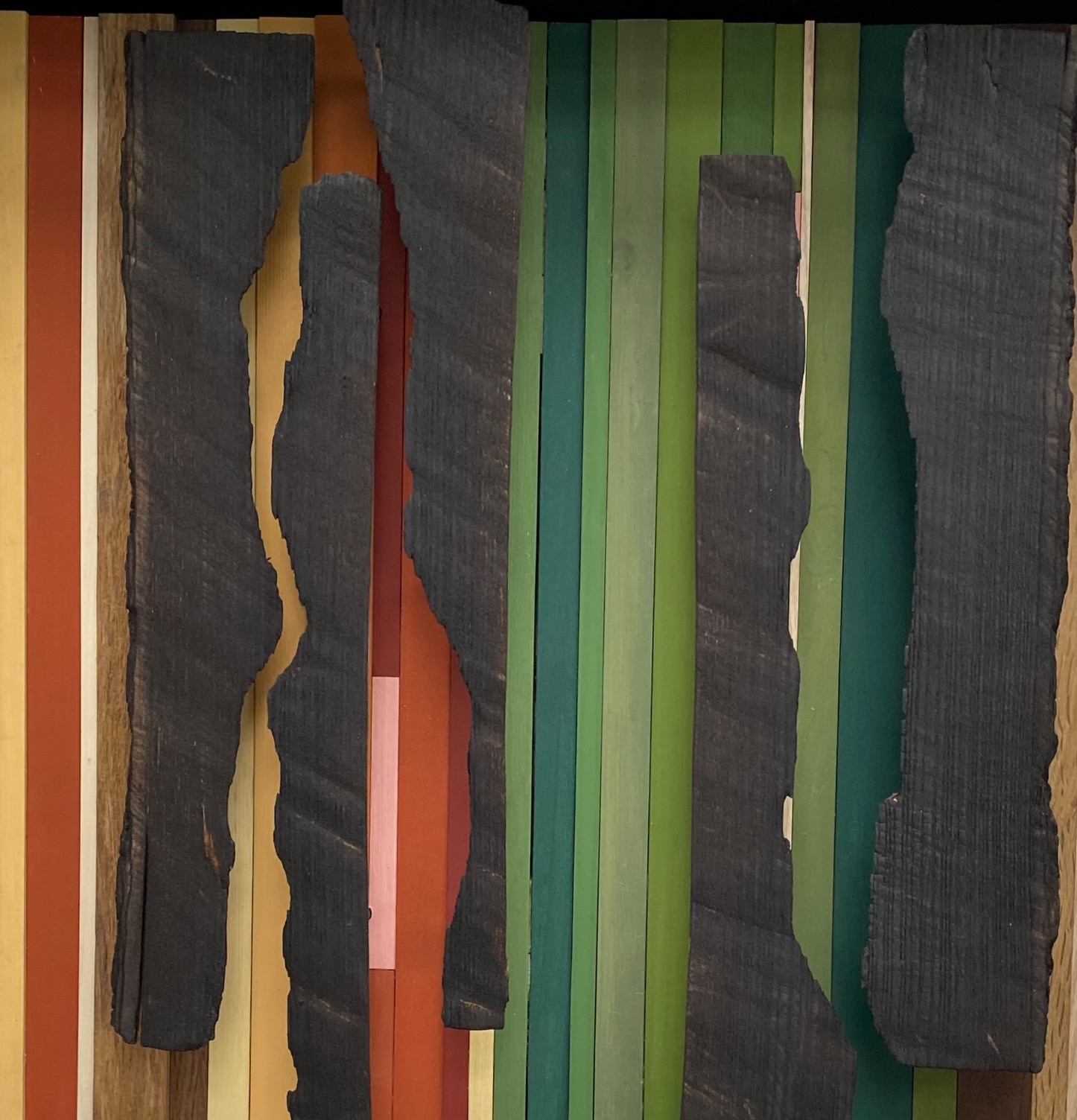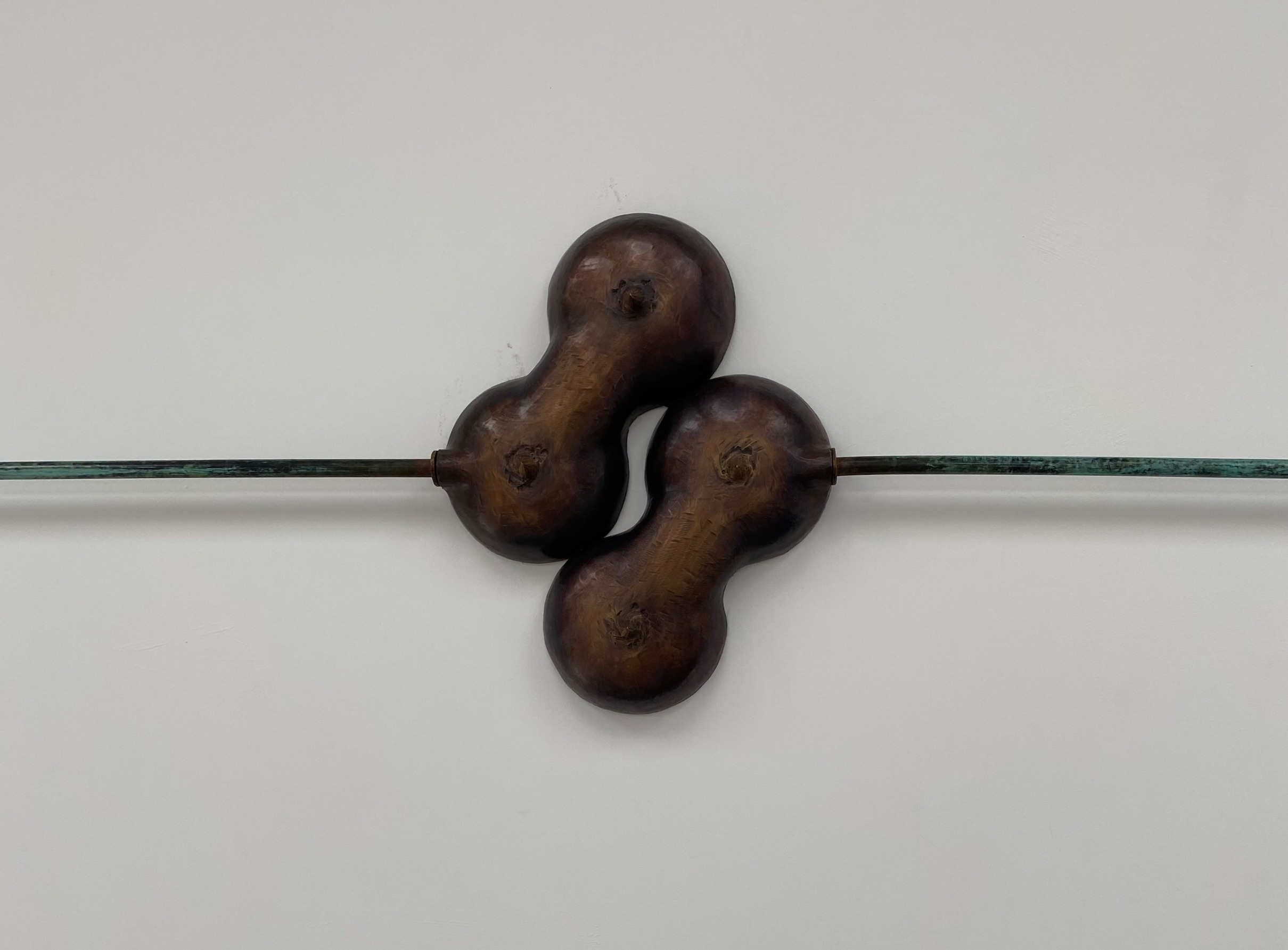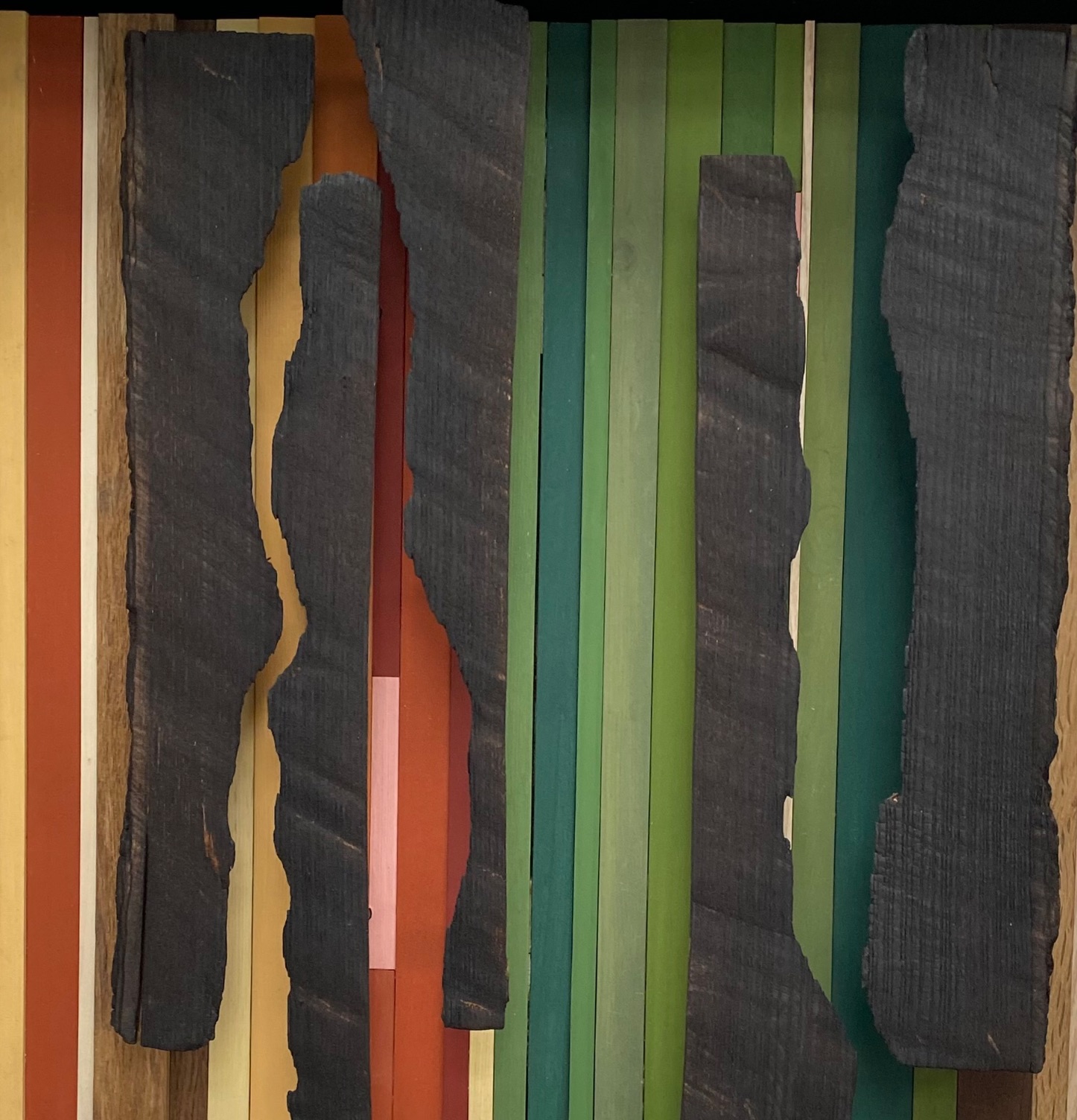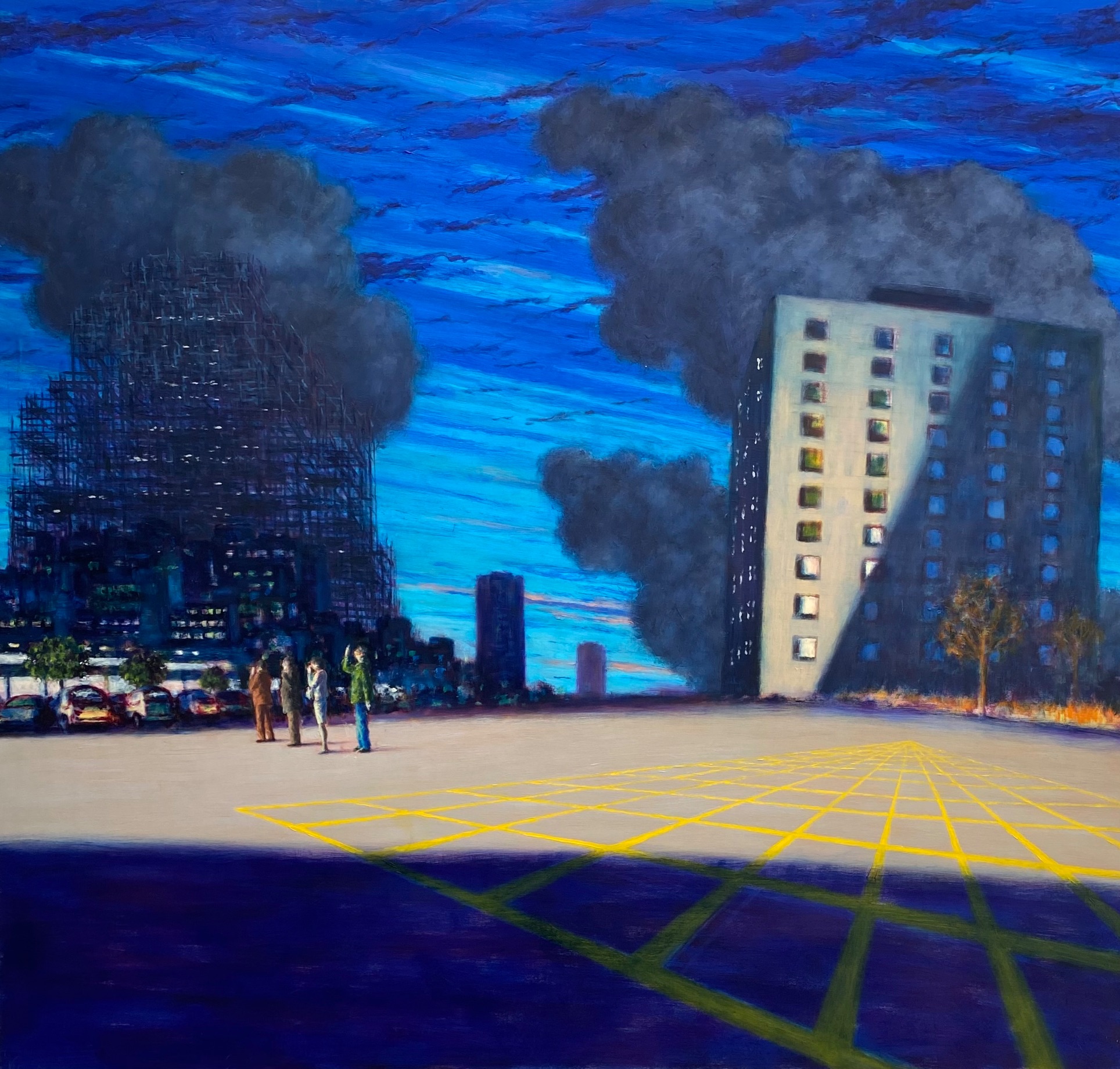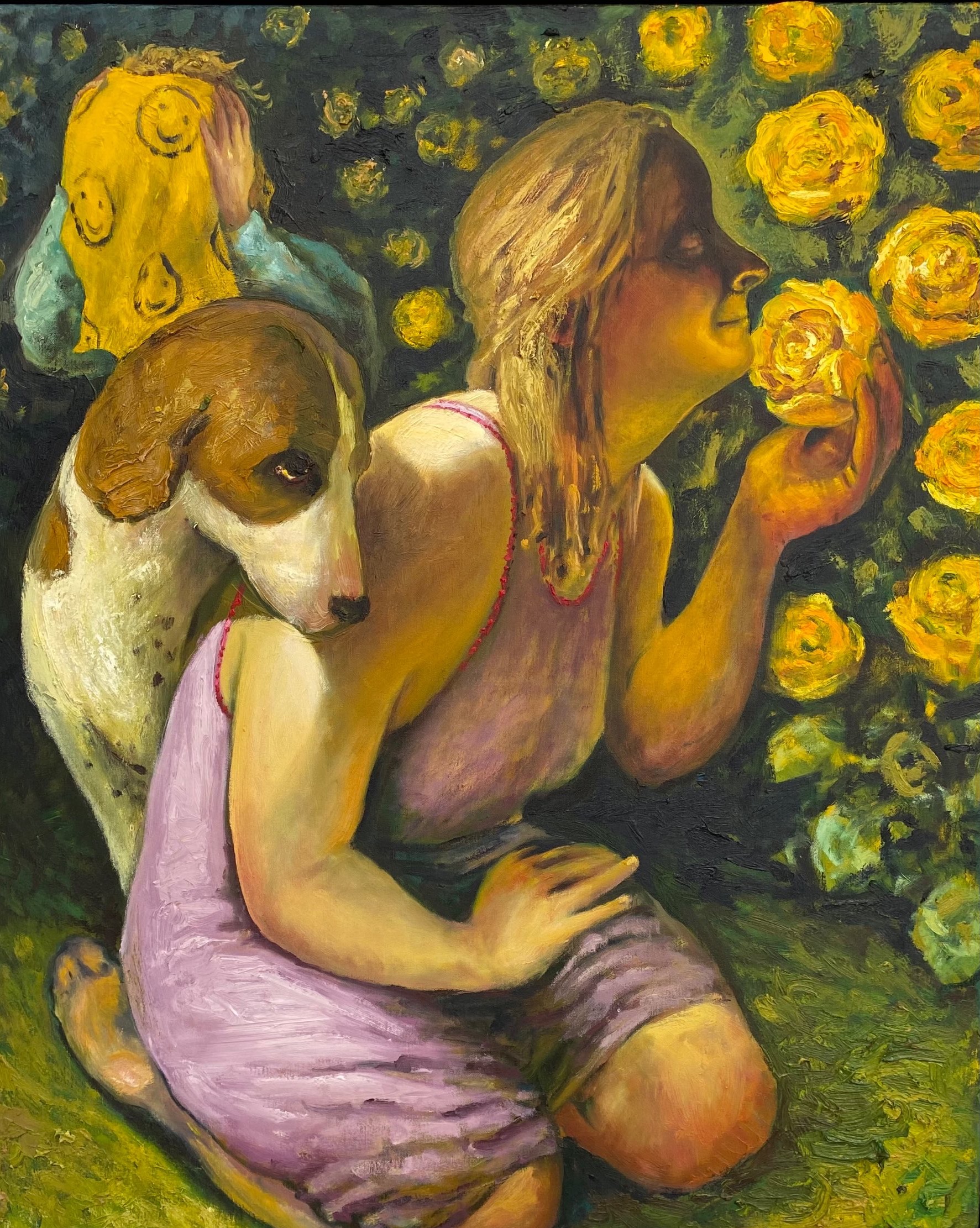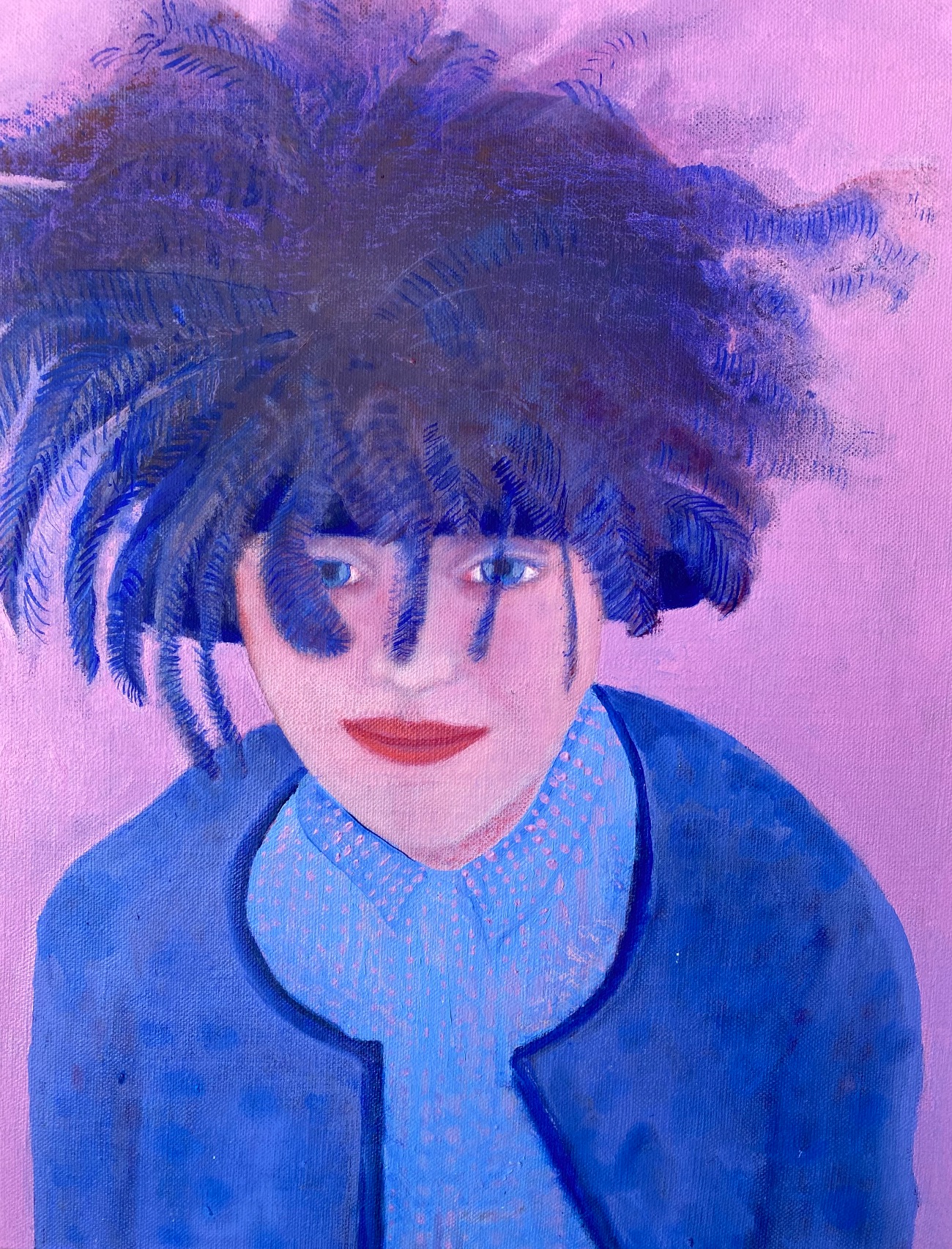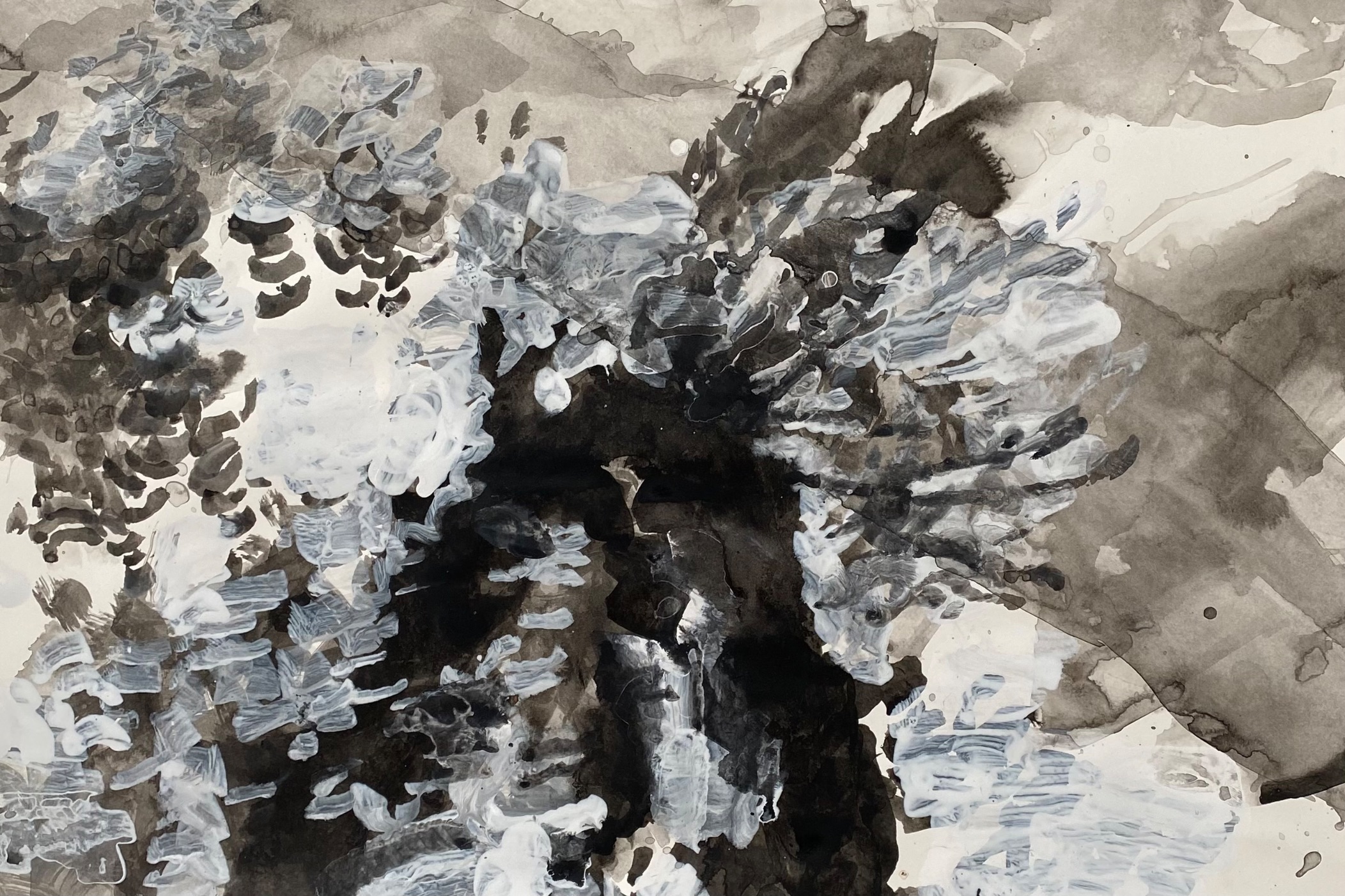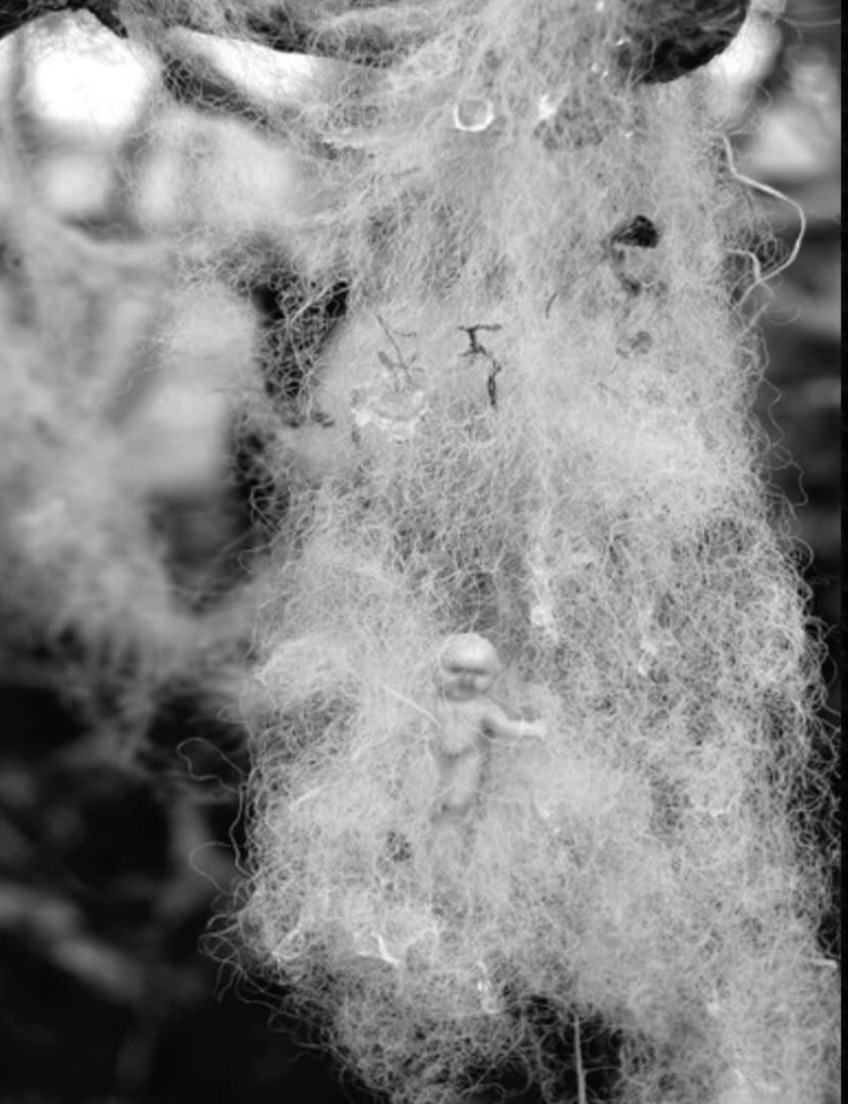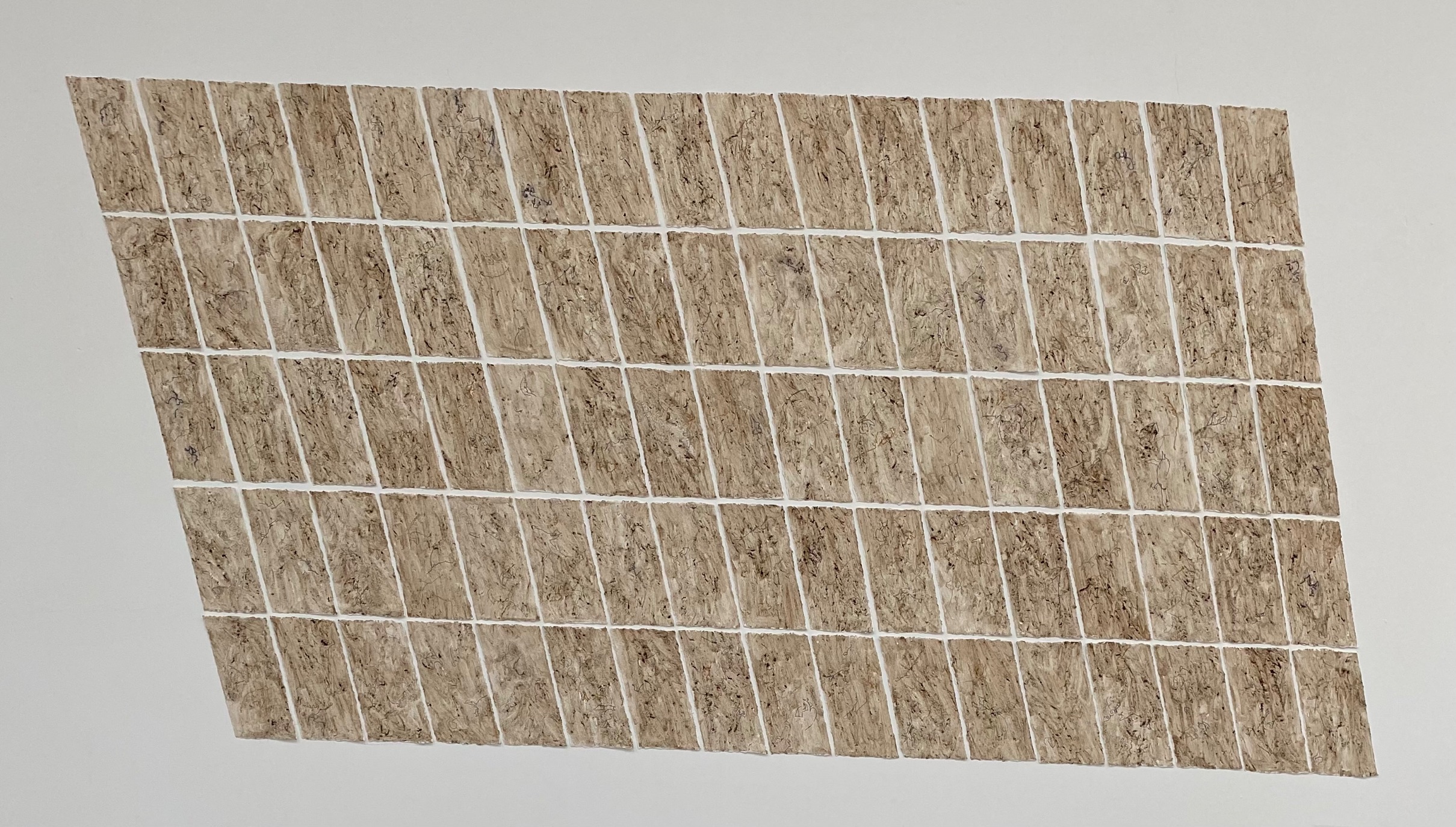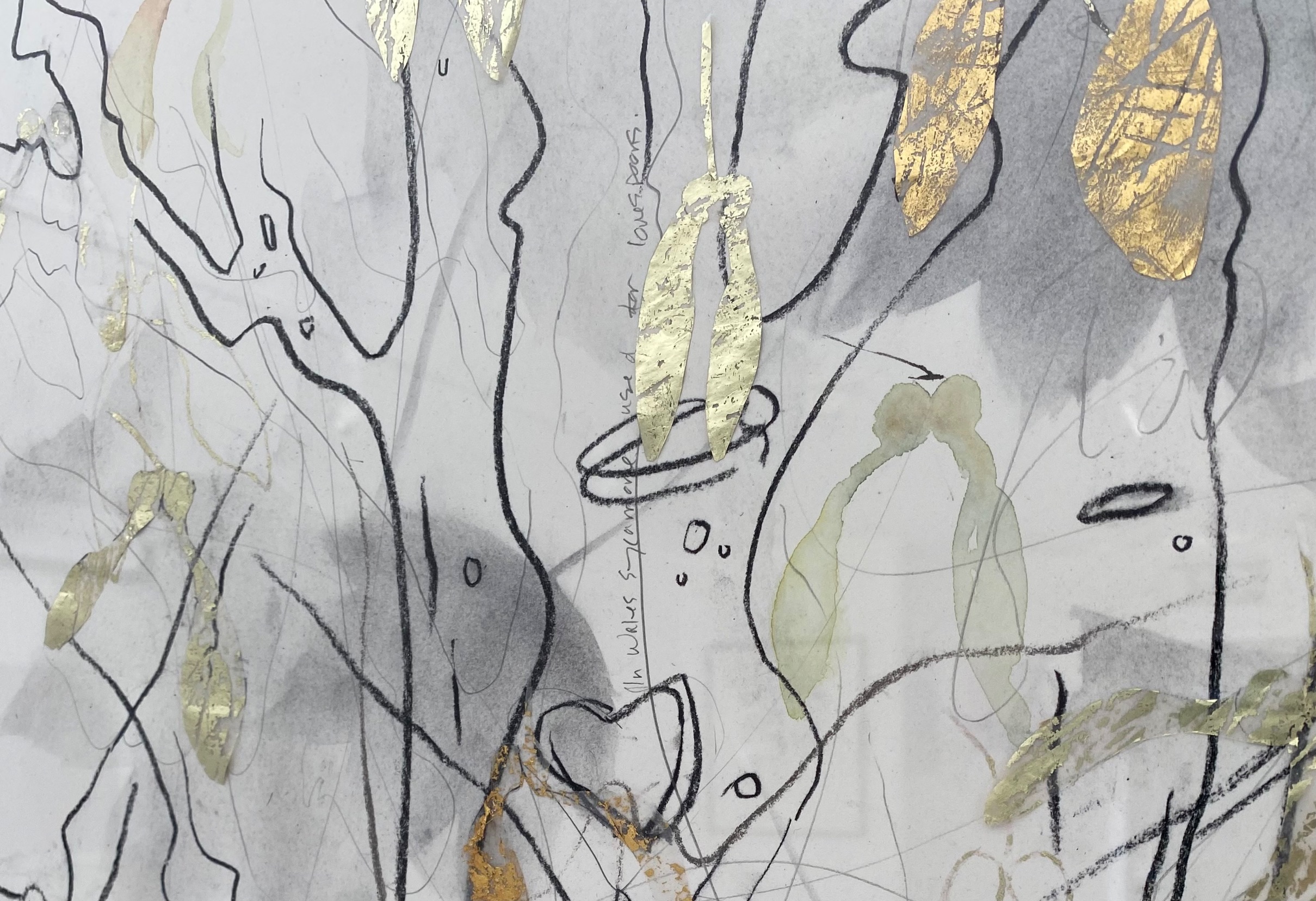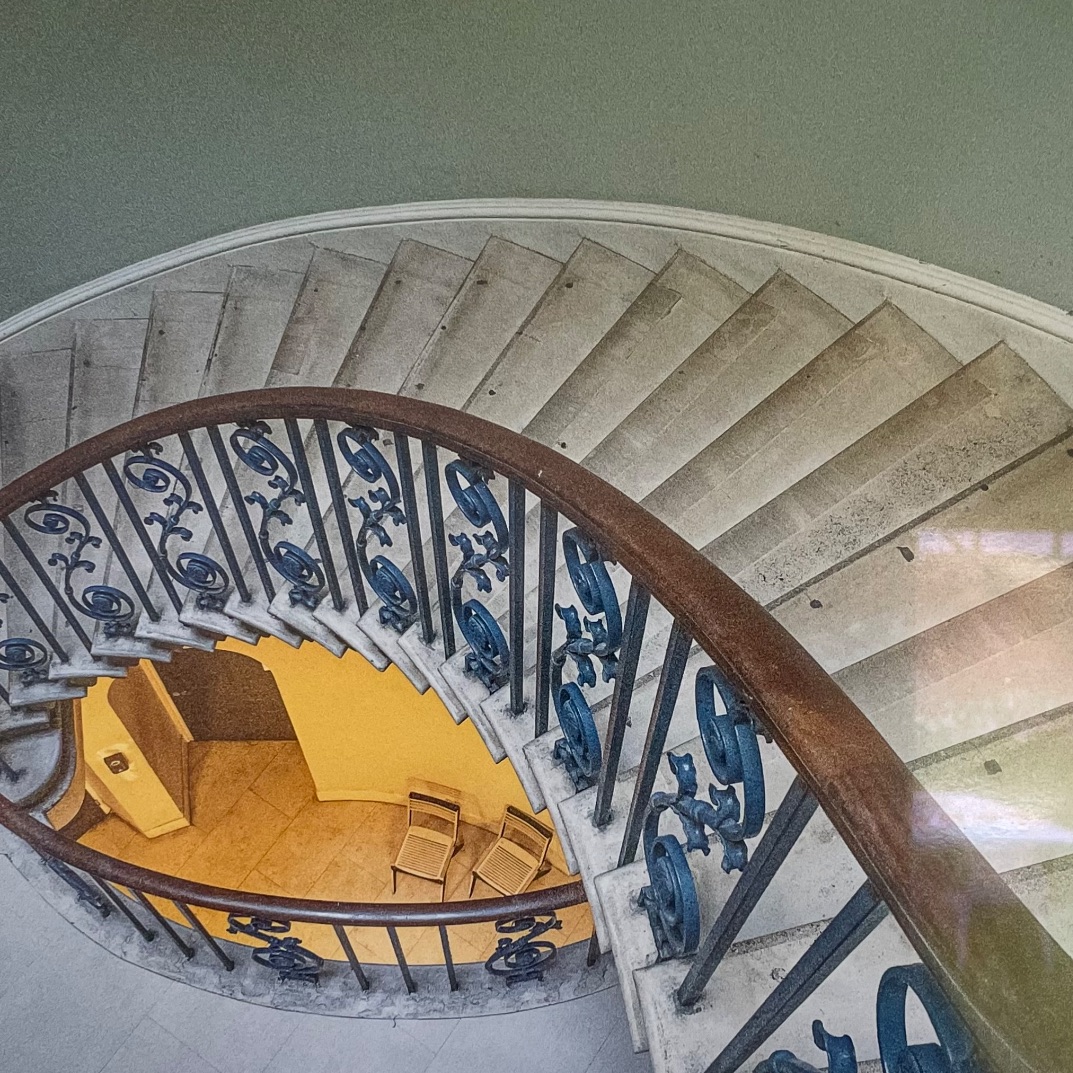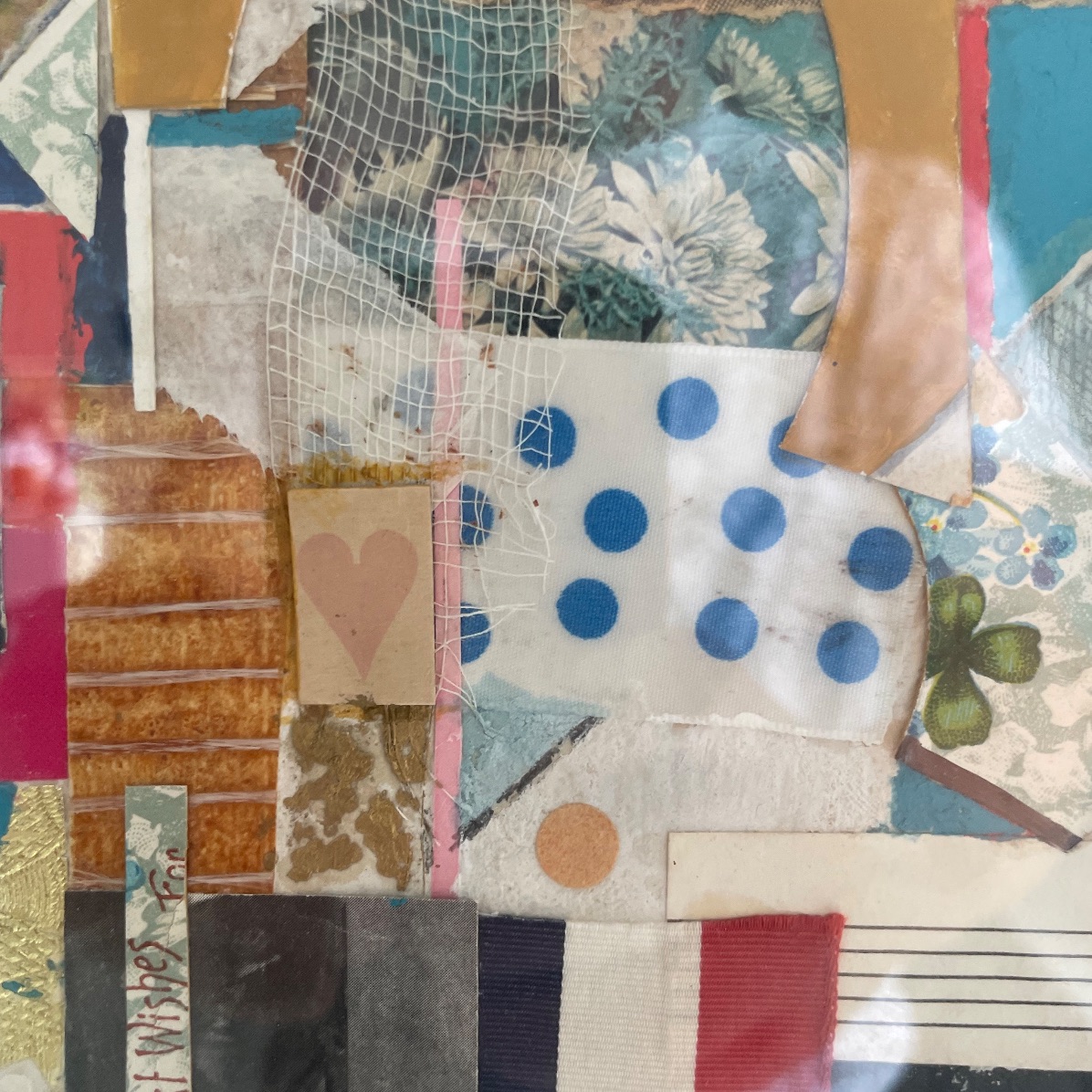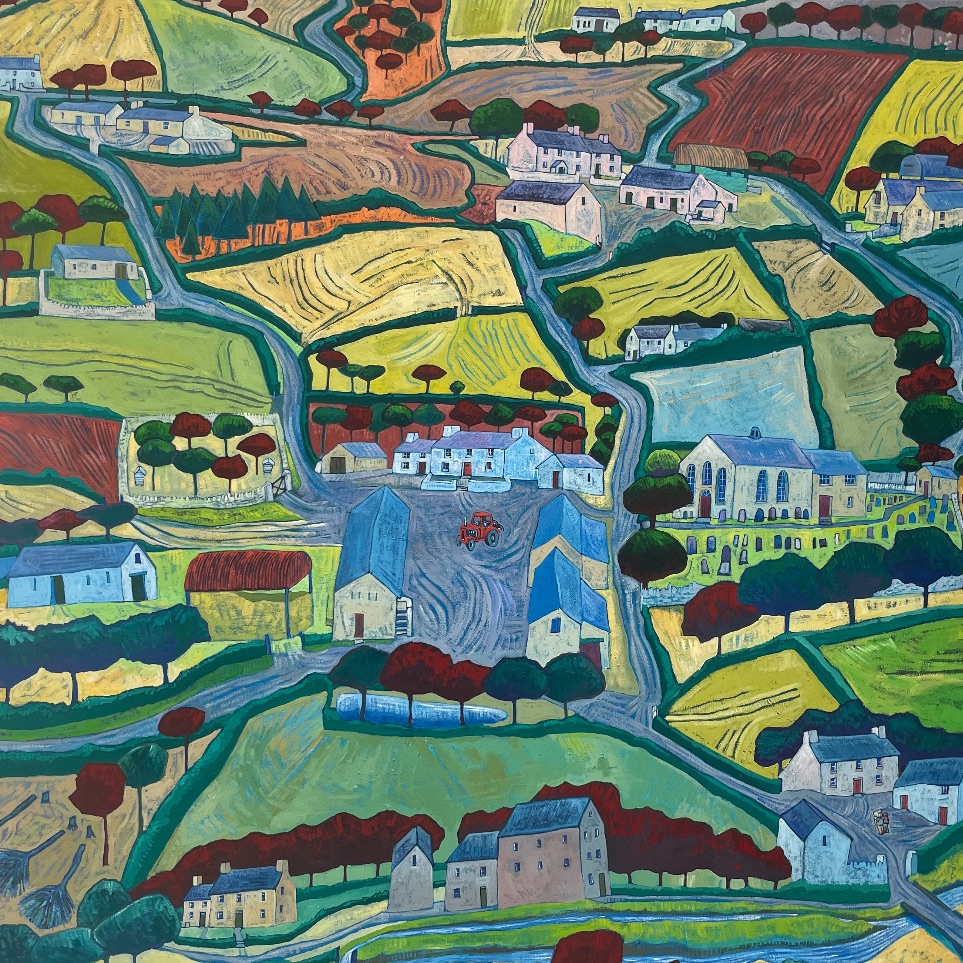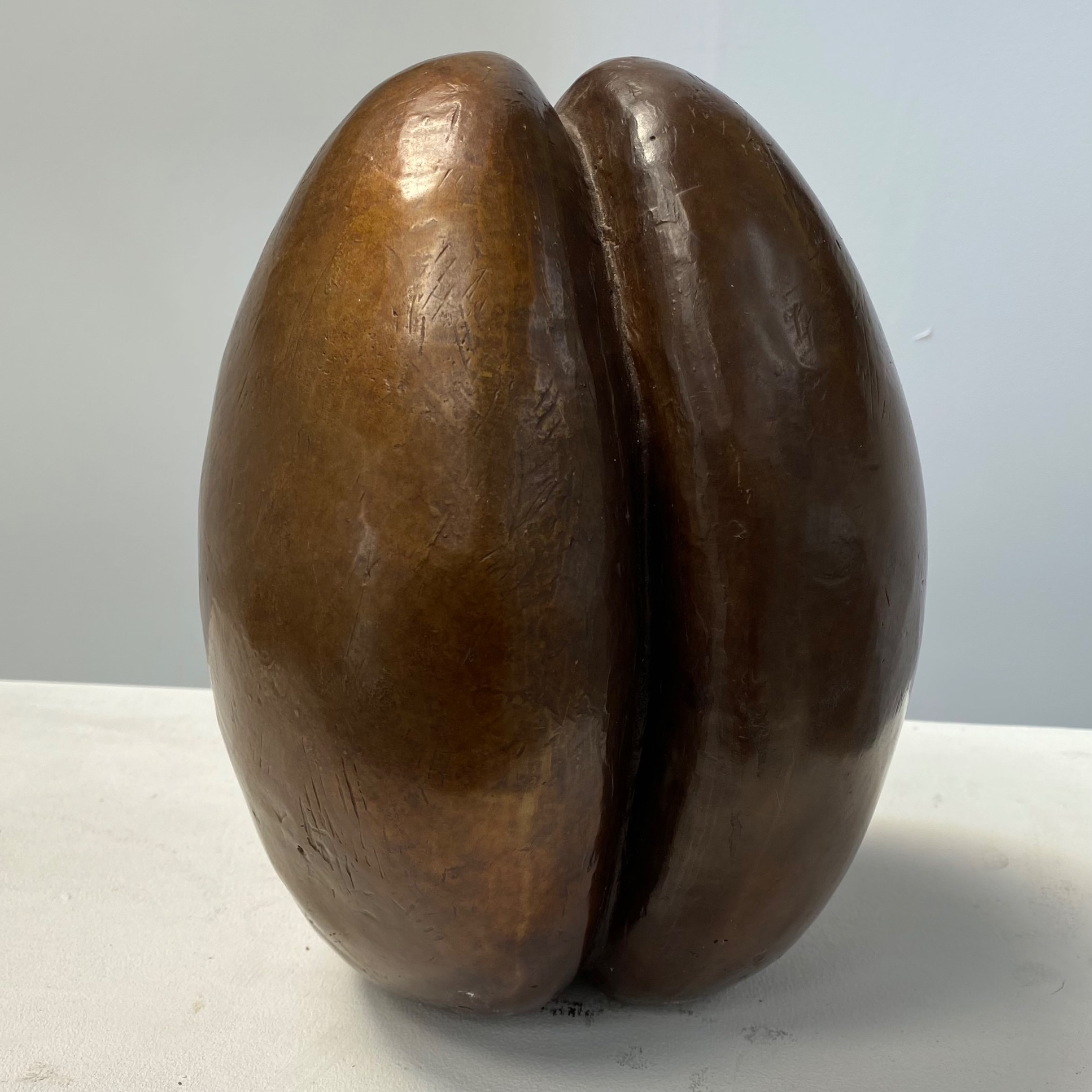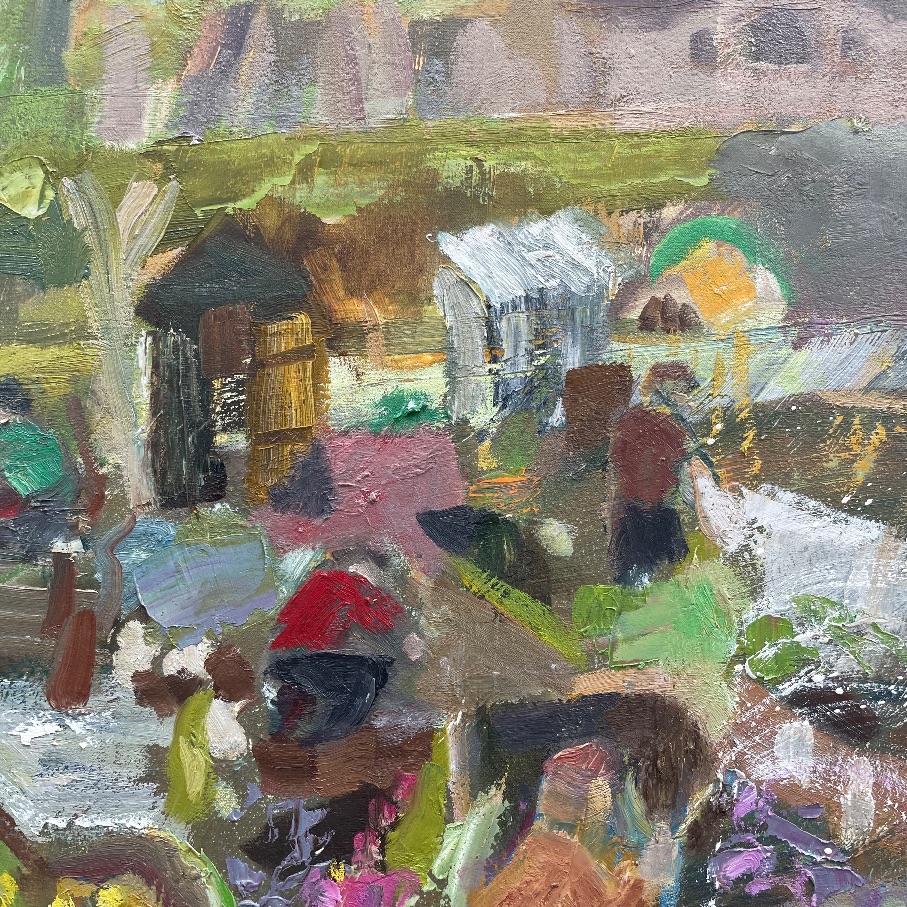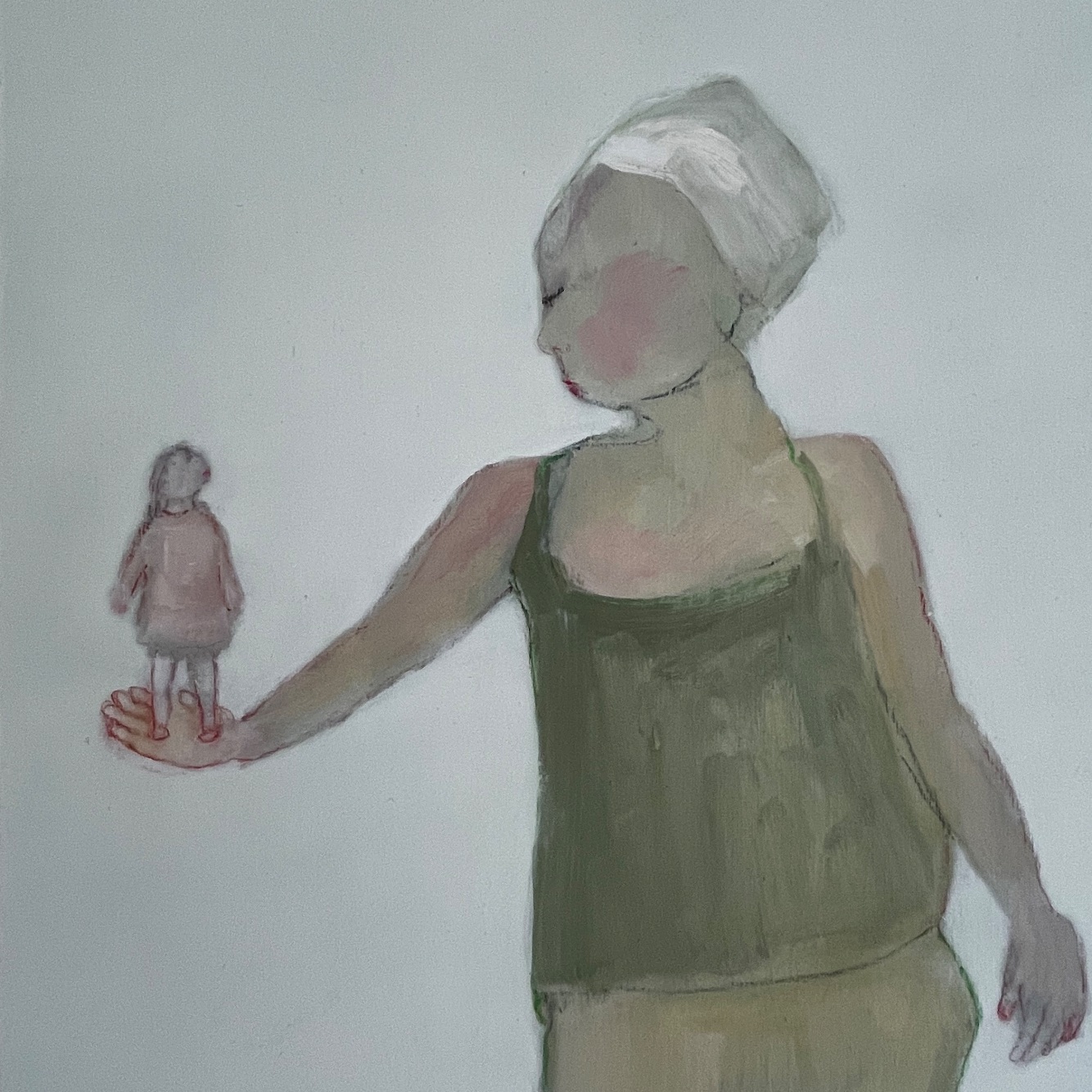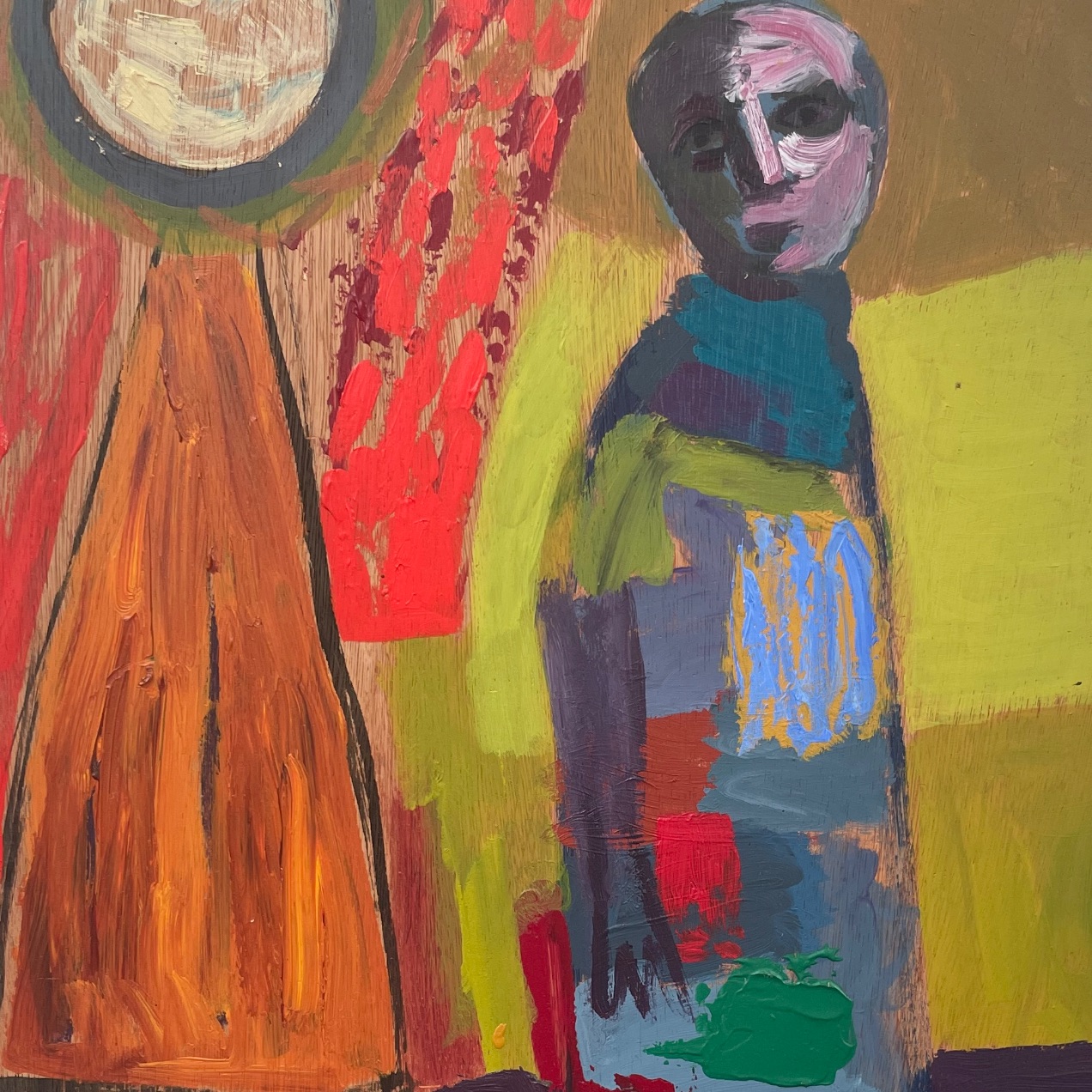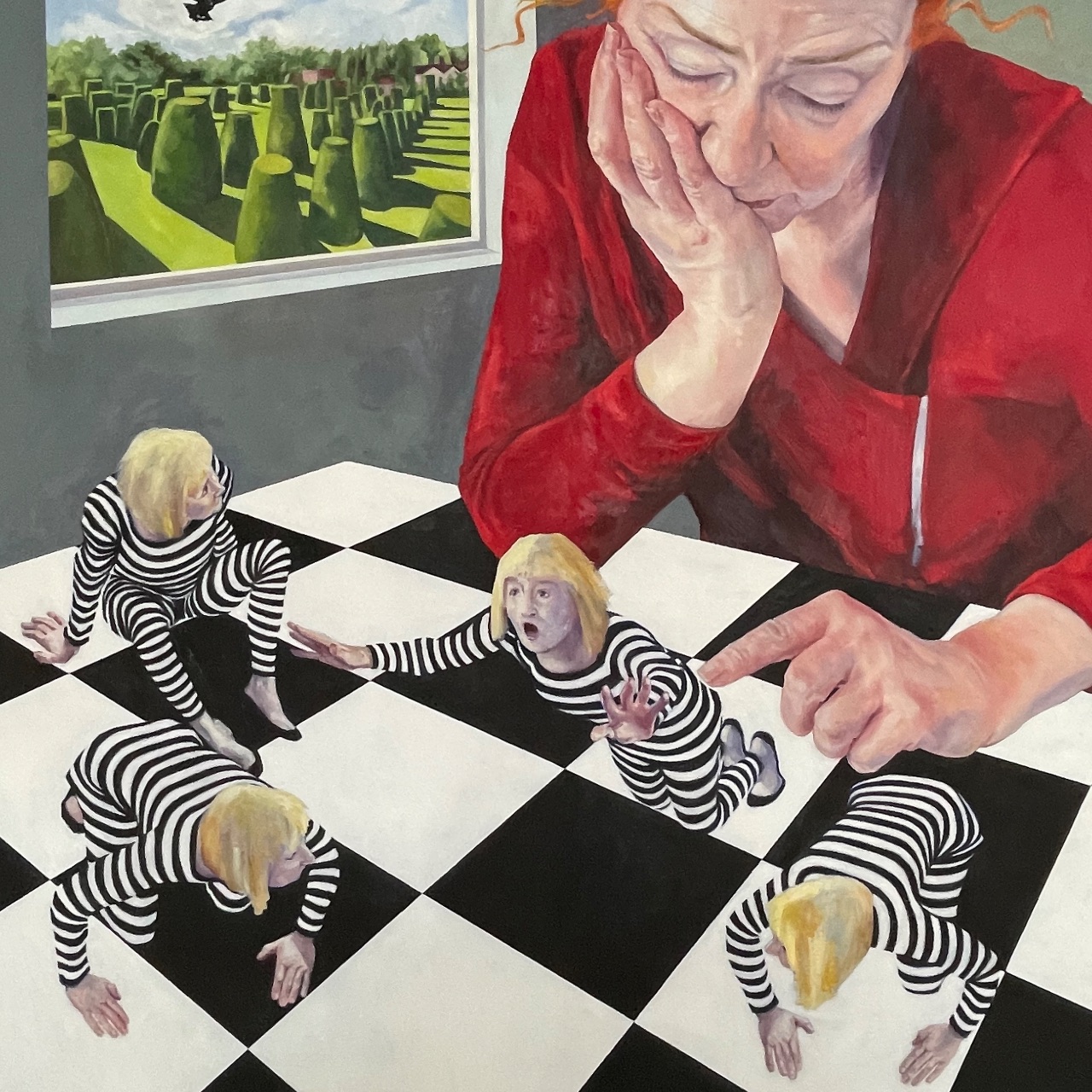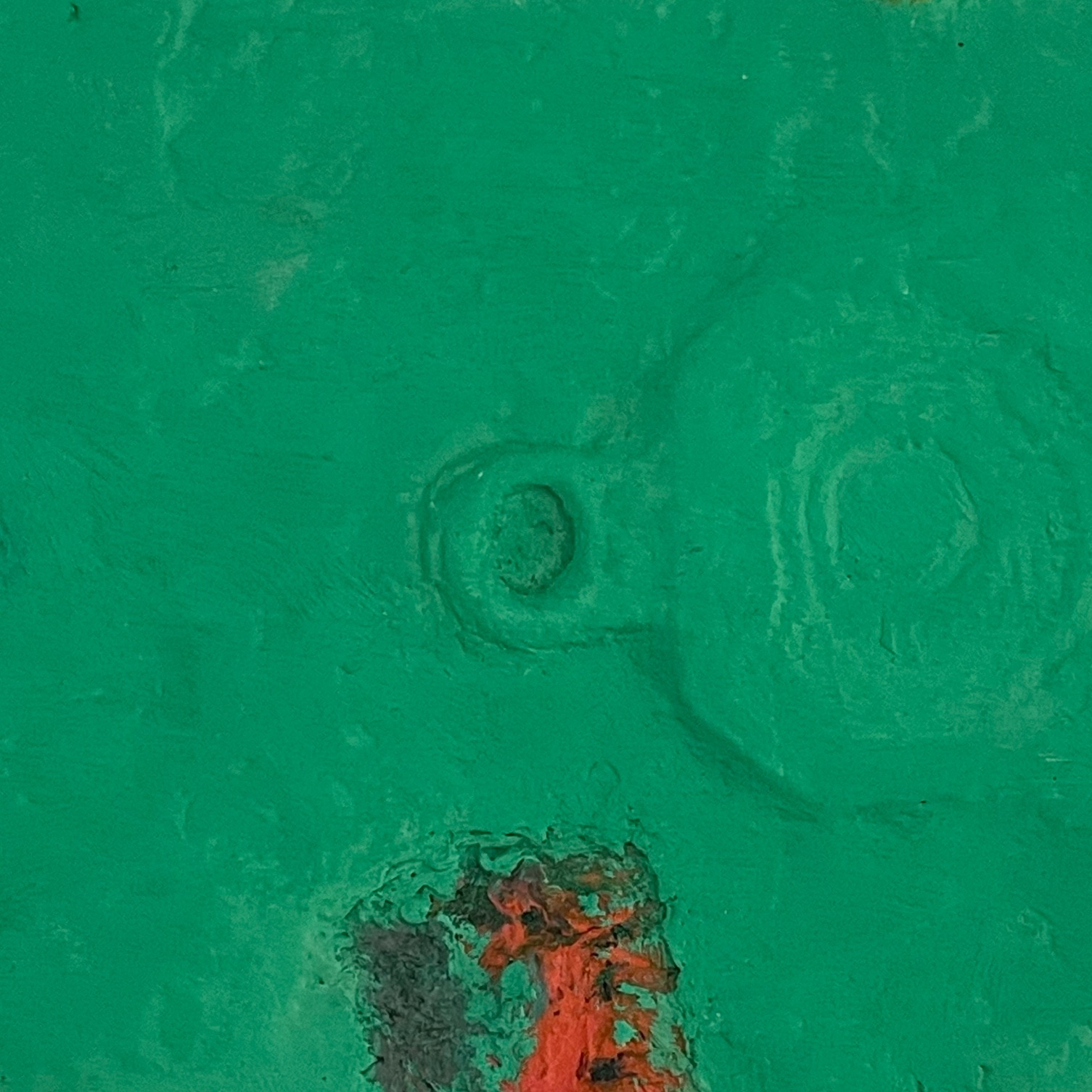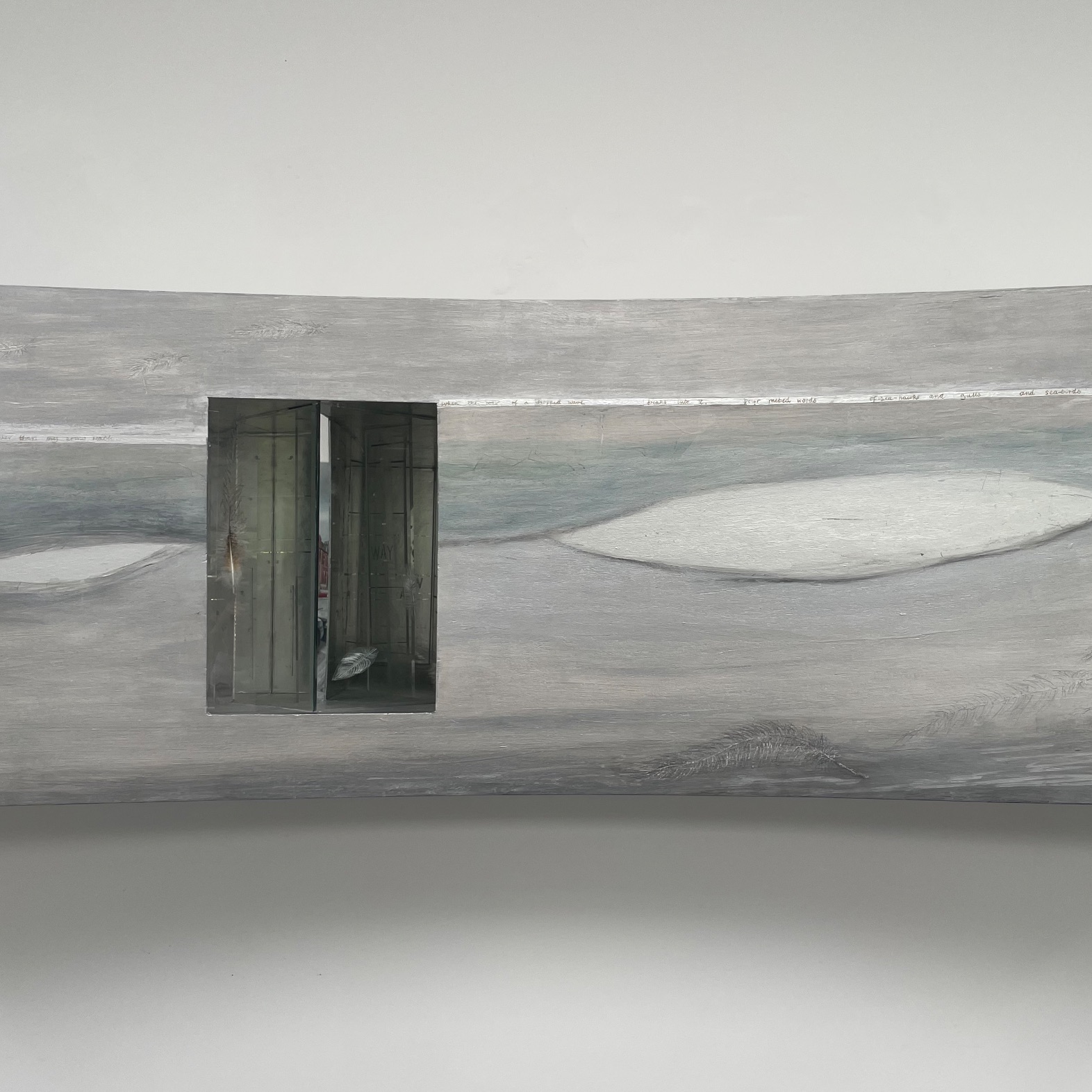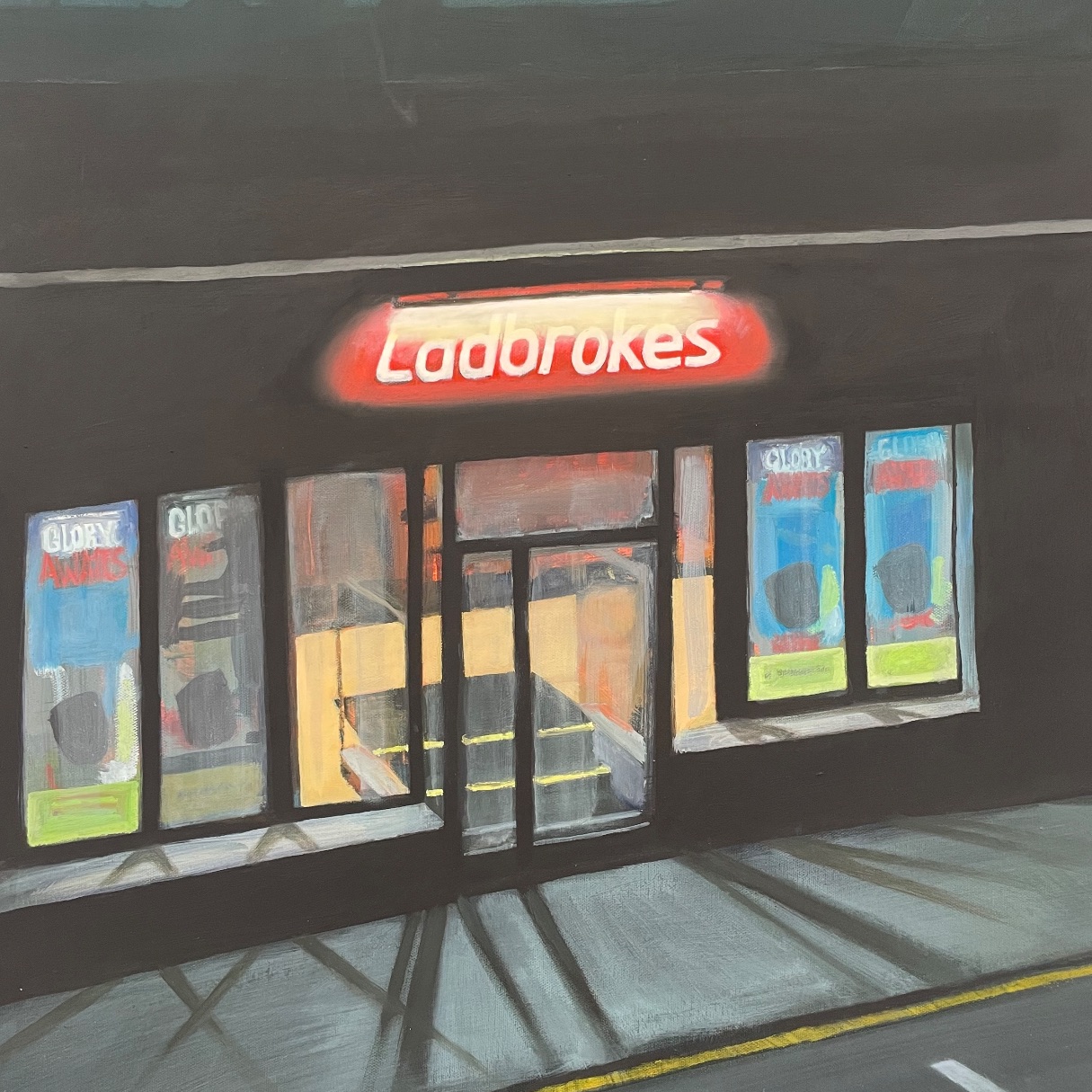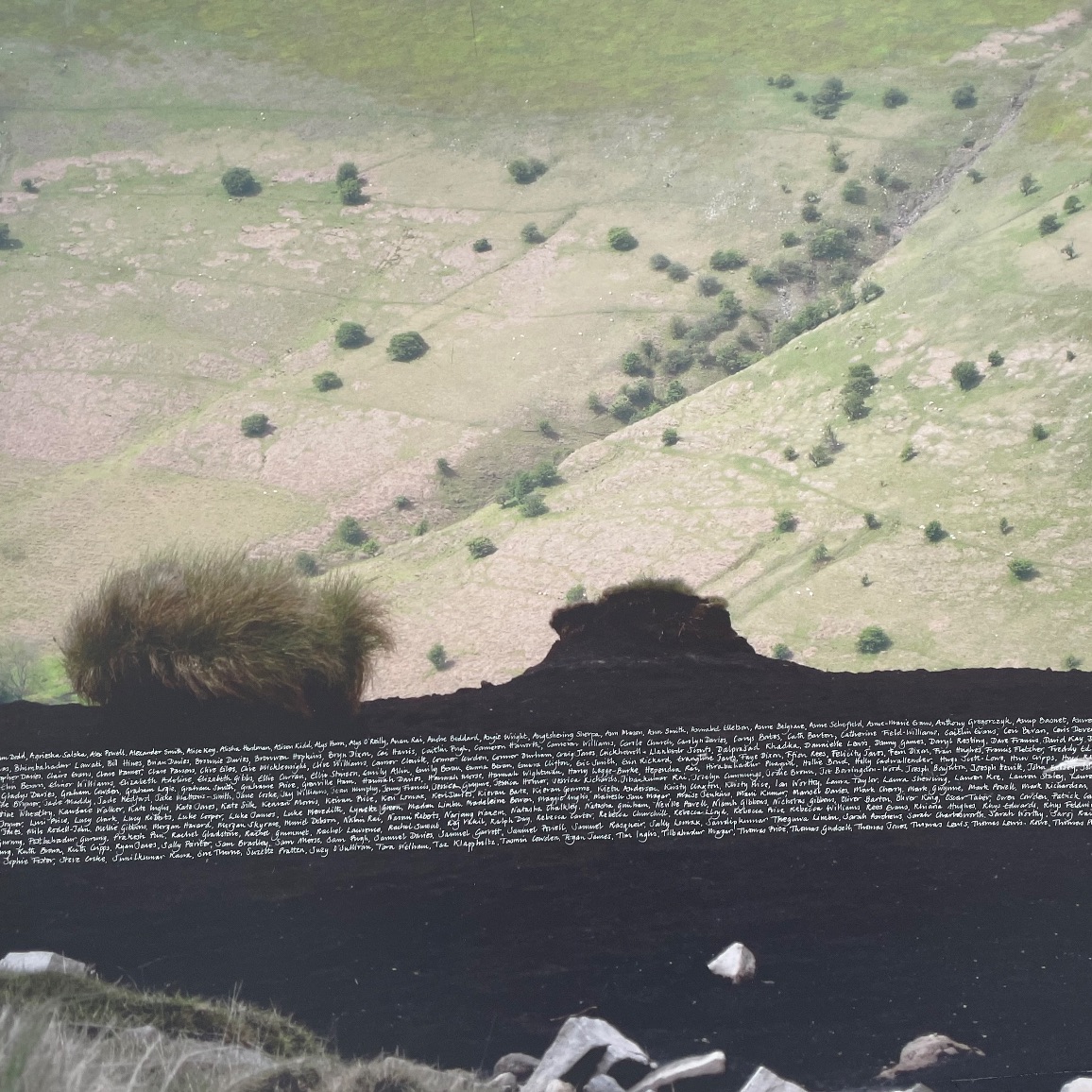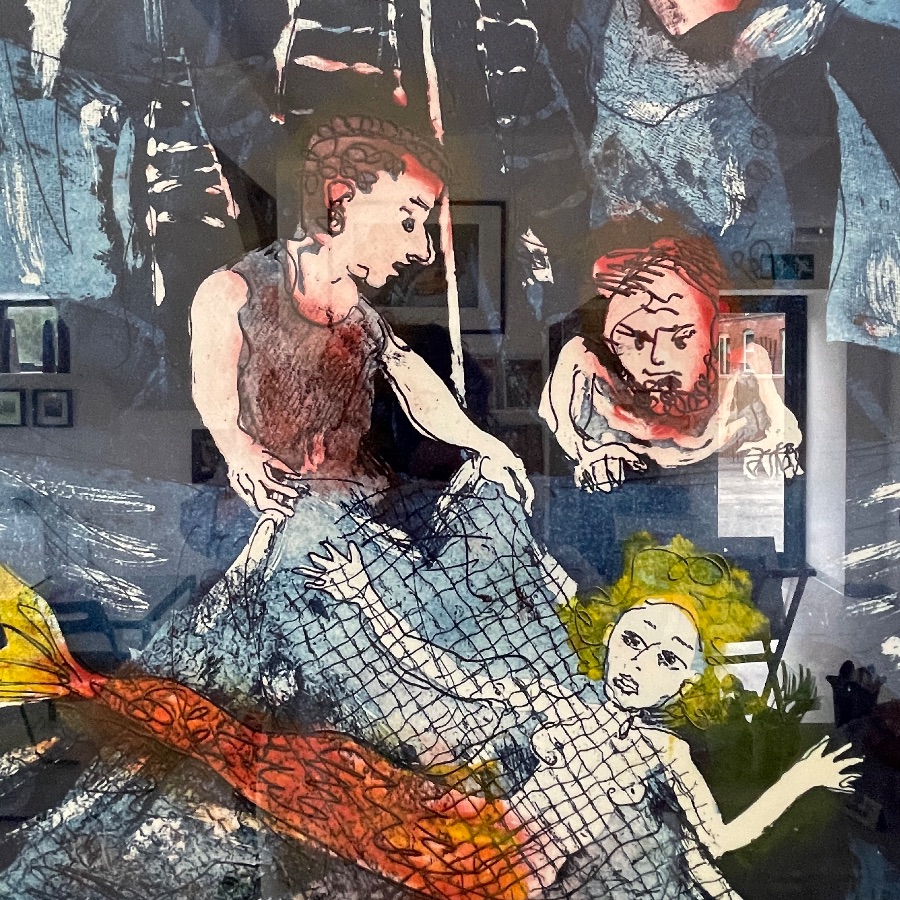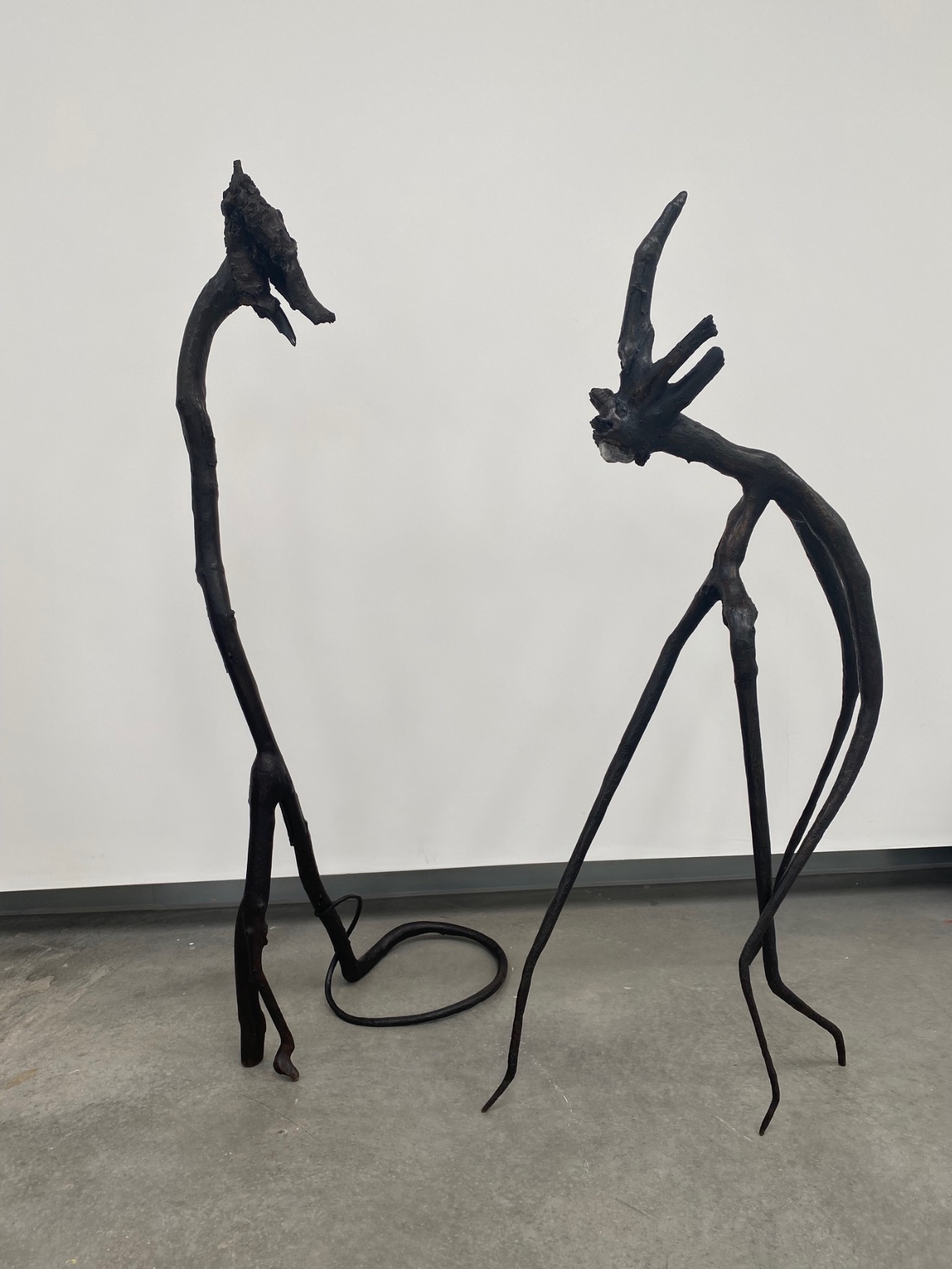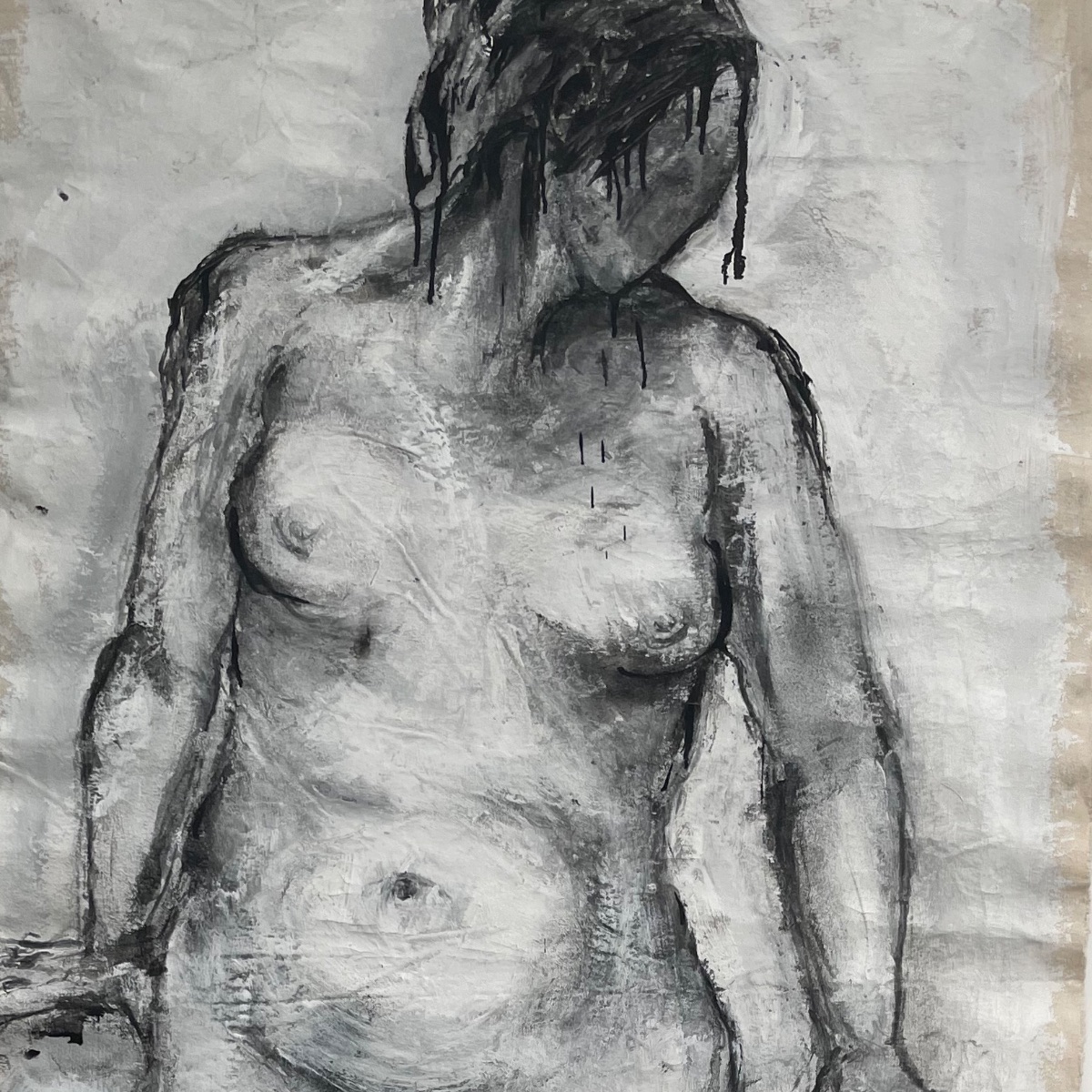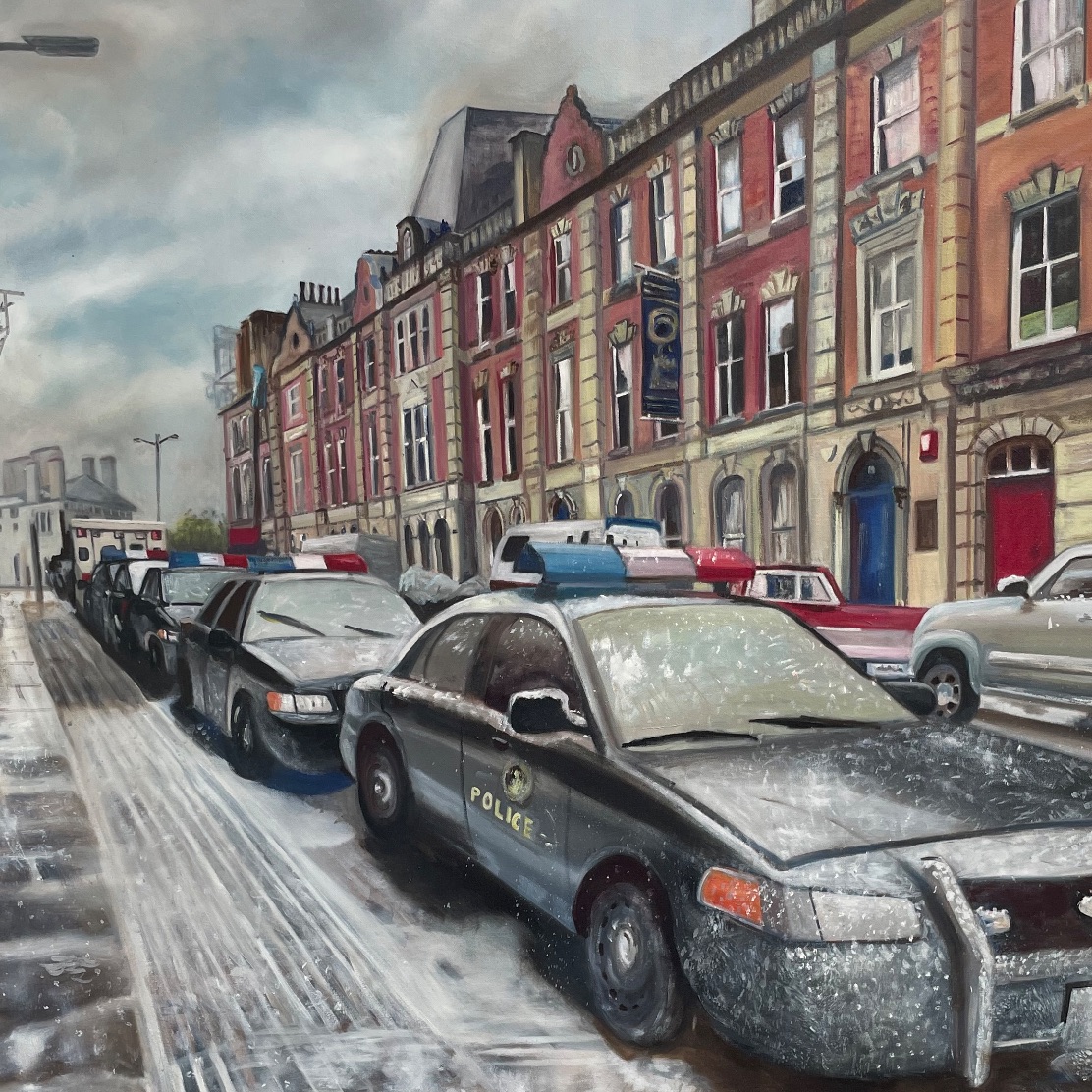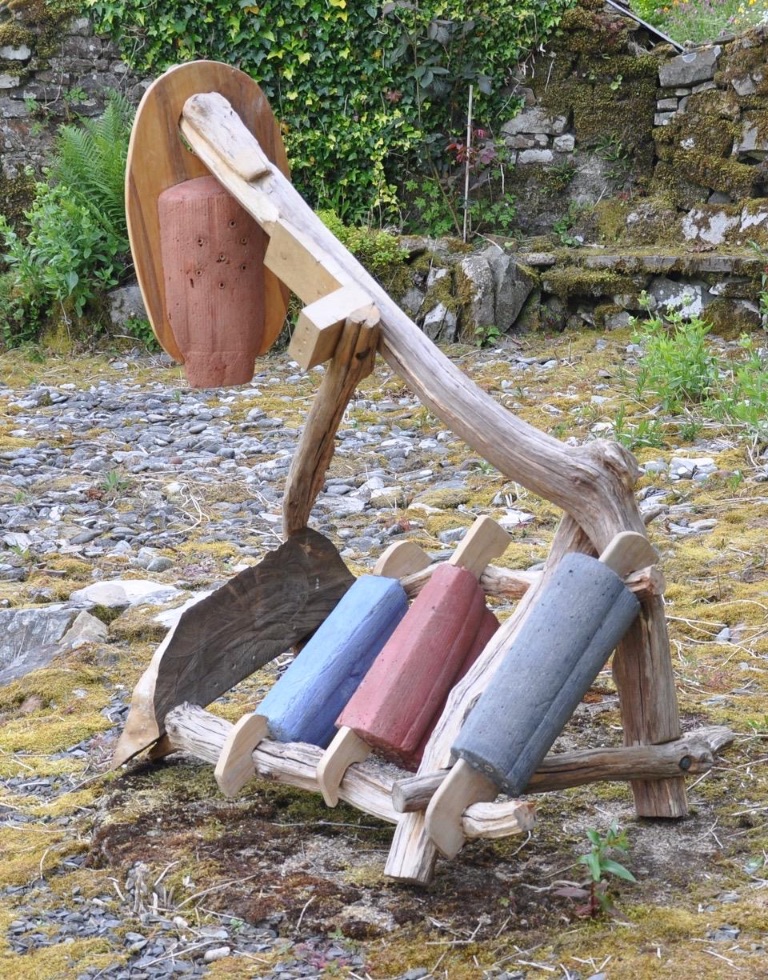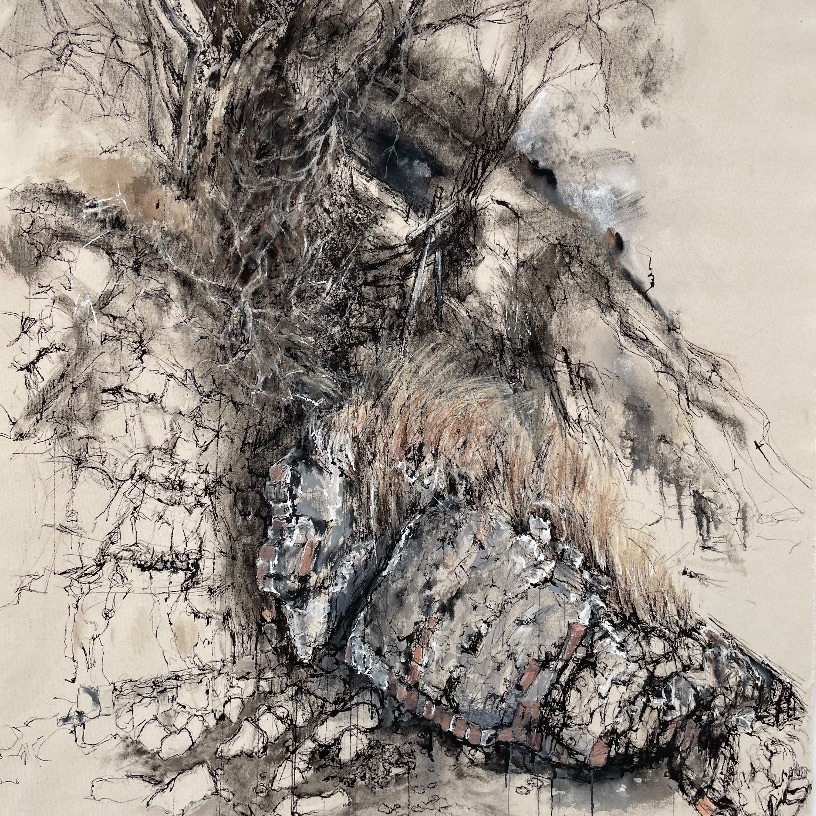How Green Is My Art?
Sunday, 9 July, - Sunday, 3 September, 2023
-
Overview
-
Works
This important exhibition brings together the Welsh Group, a collective formed and run by artists, and the Mid Wales Art Centre, a not-for-profit, voluntary organisation. Both groups have a mission to make the visual arts accessible - the Welsh Group by exhibiting across Wales, often away from the established cultural centres, and Mid Wales Art Centre by bringing and showing significant work in the centre’s extensive exhibition spaces.
The Mid Wales Arts Centre gives each artist here the opportunity to show work that responds to the environment and reflects on the idea of ‘Celf Gwyrdd’ - Green Art. Many responses are quite explicit because some of the artists here work with and in the natural environment, using recycled materials or responding to landscape. Other work in this show is more implicit and takes a sideways look at environmental issues
‘To see a world in a grain of sand And a heaven in a wild flower,
Hold infinity in the palm of your hand, And eternity in an hour.’
William Blake
I think the default position with visual art, and maybe all of the arts, is an engagement with environmental issues and this is because the arts are concerned with what it is to be human in the world, what it means to exist on this earth. On one level all artists are concerned with responding to existence, stopping time and grabbing hold of life.
Paul Edwards
Chair, The Welsh Group
Artist Statements -
Jacqueline Alkema
My practice centres very much on the solitary female figure/portraiture, influenced by Dutch and Flemish painting. Layers of meaning develop through the process of painting In the pieces for the 'How Green is my art' I have used a variety of greens; my contribution to the theme I don't do re-cycled art or paint from nature so why should I suddenly start doing this? In my career as a professional artist I concentrate not on a style or theme but am more interested in meaning and colour to put it plainly
Jennifer Allan
The product of my practice represents my ongoing internal enquiry. A visual metaphorical narrative arising from the dismantling of the archaic shaping of self and other belief systems that are the result of environmental impingement and are not me or mine. A process of attempting to undo the damage by deconstructing and understanding the elements. These narratives also provide a metaphor for a greater external commentary - of how the human imperative for possession and control consumes and destroys, and the need to understand this in the hope that we may undo the damage. A micro system reflecting the meta system.
Paul Brewer
A Negative View. I worked from the same studio in Cardiff for over thirty years. It was not just a place of work but housed the equipment used to produce my hand-made photographic prints. I had constructed colour and black and white darkrooms, a walk-in-size camera obscura, and a projector enlarger capable of producing an image 16’x12’ on a vacuum bed attached to the end wall. We moved to Fishguard after Christine had been discharged from the oncology unit at the Royal Glamorgan Hospital. I then commuted back to Cardiff staying over from Wednesday to Sunday, returning on the Sunday night Irish Ferry boat train. This period lasted for a number of years until I was evicted from my studio. I had not only lost my place of work, my archive store, but most importantly the tools used to make my work. A transition period followed. I will be forever grateful to Dr. Huw Owen the former keeper of Pictures and Maps at the National Library of Wales and his staff, along with Emma Gelliot at the Arts Council of Wales and Christine Wilison the former arts officer for Pembrokeshire CC, who between them oversaw my removal and transfer of my work to safety. Now without a studio for the first time in over 40 years I had to reinvent myself. You never start from the beginning again, but recommence somewhere along the track, so I began to work digitally, using one of the two first floor rooms in our house as a studio. My first problem was learning how to turn the computer on. Next was choice of subject matter as I could then begin the more important work of picture making now using digital technology. My bichromate prints look like paintings, yet they are photographs. My digital work looks photographic, but they are in fact drawn, using a form of digital airbrush painting. Appearance can be so superficial. Loosely based on Christine, breast cancer and contemporary fashion photography I hope my work deals with the superficial.
Simone Bizzell-Browning
HERD Extract of a body of work made in response to the imminent threat of climate catastrophe and resultant species extinction. As a sculptor I have become increasingly concerned with the environmental cost of the materials used as part of my art practice. ‘Herd’ was a conscious attempt to use predominantly recyclable materials and to reduce my personal carbon footprint. These works were primarily created from driftwood collected from the beach where I live in West Wales
Heather Eastes
Paper faced Herms – An Installation. Six paper faces stand like ancient herms, bodiless local gods, nature spirits, together with a Clown face and Putto face. They are all modelled from papier mache - flour and newspaper, sleeping or dying faces, transient images that remain in memory. They are made to be gazed down upon. Set in in cases which have no glass , they are separated, preserved – as specimens, relics, curiosities,- or Sleeping Beauty, SnowWhite, saints…, gods, fairies, nymphs of places, childhood, remnants of fire, war, pollution.
Paul Edwards
Drawings contain time, across minutes, hours, some-times days and the drawings here are increasingly concerned with making time visible. I see landscape as a subject that allows me to observe change, the action of wind and light, growth and decay - time’s damage. The materials I use to make these drawings are simple - Red Earth, ink and paper - but the ideas are complex, how what’s seen in real time as a sequence can be a drawn image. The antecedents for the current work are more early pioneering photography - ‘The Pencil of Nature’ as Fox Talbot called it - than drawing and painting.
Anthony Evans
‘Crossing the Teifi’, ‘Red Tractor’ and ‘Autumn’ are three ‘memory maps’ that reflect a Welsh countryside of half a century ago. This is the Cardiganshire of my childhood, the small mixed economy farms, the compact fields each with their descriptive names; the lively chapels and villages – reflecting a thriving culture. Today the picture has radically changed- larger farming units with industrial sized fields; depopulation and the Welsh culture and language under constant threat. ‘Time 4/5’ again has as their main theme the way memory folds, which happens repeatedly as you get older. A photograph or a found object often becomes the catalyst for forgotten memories.
Chris Evans
These three digital photographs are inspired by my interest in design, shape and pattern. All three are of buildings which date originally from the 1700s but have required additional maintenance work of repair since those early days. They are the Dean’s staircase at St Paul’s, the Nelson staircase at Somerset house and the wooden staircase at Fortnum and Mason’s store revealing how the original stone, wood and metal has been used and endured.The worn treads hold narratives of Man working with, and respect for our environment and inheritance. As well as being beautiful, these architectural masterpieces of different design represent our relationship across time.
Veronica Gibson
I have been drawing and painting at Watton Allotments since 2000, when I moved to Brecon from the Taff Merthyr Valley. I had lived there for ten years and enjoyed half an acre of land on a hillside. In Brecon I have a back yard and so I craved some land to work and grow organic. My Irish Grandparents had been farmers and my parents had an allotment in London during the war. Growing up in Herfordshire we had a lot of freedom to roam and explore the landscape. So having an allotment has created a link to my childhood. What I am drawn to is the creativity of constructing sheds from discarded house fittings and skip reclamation., its reminiscent of the 'Make do & Mend' of the fifties, I'm reminded of building camps in the woods, being resourceful & playful. Sadly some of these fabulous constructions are disappearing as the 'Flat - Pack' brigade have arrived to grow their own in neat lines. I have often thought of the allotment space as a large playground. There is interaction if you want, but often growers are in their own thoughts and world. There is a freedom and space to reflect and observe nature at close quarters. I am fortunate in that I find endless inspiration through the seasons. Gardens, like art reflects the makers personality. I prefer the re-wilding approach, where there's a place for so-called weeds. Nature led reverts to its own balance.
Chris Griffin
I have always collected stuff, thinking it will have a creative use one day. I collected the Observer colour supplement as a student and it became invaluable as a resource for imagery in the making of collages. This is a form of recycling which has stayed with me, using all sorts of material in my artwork and also as a stimulus for making images. Latterly it has stretched to saving the surplus paint from my palette and using it as a medium in creating new imagery.
Robert Harding
Making anything requires energy and materials – sculpture is no exception. However, I try to curtail my ‘footprint’ as much as possible. The pieces exhibited here use line to extend the impact of the work with only a small amount of material. Casting of bronze and iron uses energy to achieve the correct temperatures to melt the metal but the foundry I work with, operated by one of my ex-students, runs on waste cooking and motor oil in home-made equipment. A tree is also planted at the foundry premises after every metal pour.
Sue Hiley Harris
Revealed represents a significant environmental structure which is, nevertheless, hidden below the visible surface. Its value, in the artwork, is not only exposed but is also reinforced by being made from a precious metal, in this case silver wire. The oxidisation may be seen as another layer of concealment. Revealed is complemented by an arrangement of repeated rhomboidal-shaped drawings of woodland leaf-mould and stick fragments covered with a wash of wet peat. Suggested by the slices of turf-spade cut peat, the decayed vegetation, a store of carbon, further reinforces the message of hidden value in an age of extreme environmental change.
Mary Husted
The works I am submitting for this exhibition span thirty years. They include landmark pieces. The concerns governing my life are the ones that inform my work, which may vary in appearance, from the boxes to the panels to the more recent focus on books, but the same obsessions inhabit them: loss, love of landscape, flora and fauna, and a ‘sense of being there’. These are the leitmotifs running through them all, together with a spirit of experimentation with materials and mark-making. The work itself is not 'green', but my concerns are.
Dilys Jackson
For many decades I have been working in a variety of materials. I have used off-cuts of stone, wood and leather. I cast in iron which is sourced from old drain pipes and other scrap. Bronze and iron can be melted down and reused. Wood can be reused or burnt for fuel. Stone can be reused for building. My materials touch the earth lightly. My subject matter references the fragility of the natural world
Maggie James
Five ‘Walking Dream’ paintings on rice paper refer to a walk down an old road, where glimpses through trees reveal a megalopolis beyond comprehension. Fragments of the past co-exist with glimpses of the future, towering up above and plummeting to the sea below. Chinese ink and watercolour are used on vertical sheets of rice paper. All the materials are biodegradable and originate from natural materials - the ink from burnt cedar cones and the paper from rice. The paintings were part of a collaboration called Paper Exchange, part of Open Books
Jacqueline Jones
My work The Path Of The Sun In The Green Desert represents my love of the Healing colours of nature. We are more aware of ecological concerns these days. I have used recycled board in the creation of this piece. The Green Desert refers to Mid Wales, sometimes poetically known as the lush green desert of space that it is.
Kay Keogh
I have entered two paintings in the exhibition, ‘How Green is my Art.’ The justification for this is that they both have been painted over many times and then reworked and reworked. It’s an annoying habit of my practice as I lose many paintings along this process because I’m struggling to satisfy myself with the outcome. However although I’ve never thought of it before I suppose it could be deemed as recycled art. In these painted portraits I am exploring/ questioning how facial expressions reveal inner emotional concerns.
Angela Kingston
From my garden. My garden has been a large part of the inspiration for my work for many years, together with plants in their own landscapes. During Lockdown and throughout the Covid years, the awareness of climate change and the need for trees magnified. I started a new series of work on the trees in my garden, drawing, writing , painting, collage and installations from garden finds. Starting with Ginkgo Biloba, Silver Birch and now Sycamore.
Robert Macdonald
I began painting in New Zealand as a teenager but as there was no possibility of attending art college I trained as a journalist. Returning in 1958 to Britain where I had been born I studied painting and printmaking at the Central School in London. Out of money I returned to journalism and worked in Fleet Street throughout the 1960s. This has been a pattern throughout my life – periods of painting interrupted by periods of writing. Living in Wales I have turned to landscape and to Welsh legends for inspiration but as my etching Uncharted Seas demonstrates the romance of the Pacific still haunts some of my picture making.
Karin Mear
I’m very conscious that the knock on effect of online shopping has led to worsened traffic congestion and transport related carbon emissions and while it’s often convenient to shop online it’s not environmentally friendly. My work often explores family themes, particularly with a Welsh theme and my piece, ‘How Green Was My Valley’ was inspired by my memory of being wrapped up in my grandmother’s shawl. It would have been woven from Welsh wool in a Welsh mill and, in an era where shopping locally was the only option for most people, purchased in my home town - Aberdare.
Philip Nicol
As a new member this is somewhat of an introduction and I am exhibiting 3 paintings made some time ago but that remain consistent with my current practice. There are several reasons for this choice, one, they are relatively large, and two, they have a content that is anxious and unsettling. The space and environment is psychological and deliberately one of disquiet. This chimes, I think, with current anxiety about our world and hopefully is sympathetic towards the overall theme of the exhibition.
Shirley Anne Owen
A project painting National Trust sites on the Welsh Coast which are at risk from rising sea levels, led to heightened interest in the state of the cliffs at home in Penarth. Using drawings made on site together with photographs I began to develop large works on raw edge canvas in the studio. Then, circumstances helped to change my focus from the coast to climate changes in nature especially in ancient woodland. However, two unfinished coastal works came to my attention during a change of studio and prompted a return to the subject of coastal erosion.
Sue Roberts
My work deals with emotions and empathy. In my 3d work the material at the moment of choice is alabaster using slate, stone and wood to place work on. I also work in plaster, clay, bronze and cast iron.
Gerda Roper
I like to paint and to draw, and they are largely separate activities although the latter will inform the former. My subject mater is largely what I experience, or rather how I perceive things. The weather lately has convinced me that I am in the Garden of Eden. How to communicate the fecundity, the luxury, the scent of summer currently beguiles me. I am no Constable but I find the munificence of the outdoors inspiring. I love the versatility and parlance of paint, its silent doublespeak. I religiously adhere to the principle that one reads a painting as much by how it is painted as what it depicts . I love the wealth of application that paint offers one.
Philippine Sowerby
My sculptures glorify nature. Natural beauty of wood - of grain, texture colour. Sourced from local trees with grid references shown. Burning Issue and Remaining comment sombrely on current challenges. Revelation and Radiant reach out and explode with hope Flow reflects the River Usk that runs by my home Weather Beaten and Grown Together speak of the relationship between the wood and the environment around it. Sculpting is a relationship between me and my material in which I am one with nature and record our conversation in the finished piece. Rooted in my environment and community I am able to share in the continuing creation of our universe.
Thomasin Toohie
I am a ceramicist and painter living and working on the Welsh border. My work is narrative and is very much connected to my song lyrics, as I play and write folk music. The work is a distillation of life experiences, places visited, people met. Shorthand notes in hopefully universal languages. I am interested in popular culture and like to examine this in a fine art context.
Gus Payne
The narrative in my work is generally concerned with how our society appears to prefer ‘convenient lies’ rather than seriously address the difficult truths it faces. Is delusion part of the human condition? A coping mechanism? I’m interested in the relationship our civilization has with nature and how any disconnect can be realigned.
Philip Watkins
The thoughts behind these paintings are best described by part of Wordsworth’s poem,
‘The World Is Too Much With Us Late and Soon.
The world is too much with us; late and soon,
Getting and spending, we lay waste our powers;-
Little we see in Nature that is ours;
We have given our hearts away, a sordid boon!...
…For this, for everything, we are out of tune;
It moves us not.’
This was written over 200 years ago.
Jess Woodrow
"I don't think a painting can really address environmental issues very easily without resorting to illustration or sentimentality. But maybe the process of its creation can... I have allowed this series of paintings to almost create themselves. I add layer after layer of colour and texture until an image starts to appear out of the weave of the paint. The painting is solved when there is a resonance between the object, that is the stretched canvas, the colours, the textures of the surface and the space that these elements create together; whilst allowing the subject to take care of itself."
Pip Woolf
In making work I invariably respond to my immediate situation using processes and materials specific to each different subject. Woolenline is a drawing. A response to climate change made as a unique time-based social sculpture installed in the Welsh mountains using felted wool to heal scarred earth and human relationships. Begun as an observational drawing on a fire damaged peat bog Woollenline became a guide for new lines, linking people through effort, creating threads of research and opportunity. It took a serious situation and playfully encouraged over 1,000 people to make their mark, enabling connections between conflicting interests to inspire personal and community responsibility for our shared landscape.
